York University offers a range of internet access options to keep you connected on campus:
- AirYorkPLUS: Secure, high-speed Wi-Fi available across campus.
- eduroam: Wi-Fi for visitors from participating institutions
- AirYorkGUEST: An open Wi-Fi network for guests and visitors
- Wired Internet Access in Residence: Reliable, high-speed wired internet for students living in residence
- Virtual Private Network (VPN): Securely access university resources and services from off-campus locations, ensuring your data remains protected while working remotely.
Whether you’re in class, studying in residence, or visiting from another institution, York University’s internet services keep you connected and secure. To ensure optimal performance of your Wi-Fi connection, please consult our recommendations on choosing a Wi-Fi client device.
**Please note any other wireless networks available on campus at York are not supported by UIT and should be avoided.
Featured Services
Overview:
AirYorkPLUS provides wireless internet access to York community members featuring improved security, performance, convenience and mobility. AirYorkPLUS is for current students that use Passport York login for their daily academic online activities at York University.
Features:
Single sign on
Once you configure your Wi-Fi client (laptop or tablet computer, smartphone, etc.) with your Passport York credentials, the client will automatically connect to AirYorkPLUS as soon as it is within range of an AirYorkPLUS access point.
Security
Network traffic is encrypted between the client and the AirYorkPLUS access point.
Performance
Better performance in high-density settings such as lecture halls and libraries where many Wi-Fi clients are active simultaneously.
Most performance improvement are available only to Wi-Fi devices with dual-band radios. For further details, please consult UIT's recommendations on selecting/purchasing a Wi-Fi client device for use on-campus at York.
**Please note that you will only be able to access AirYorkPLUS as an active York student. Once you leave or graduate, you will no longer have access. Please consult the AirYorkGuest page for information on how to connect once you are not longer and active student.
How do I access it?
You will need a Passport York username and password to connect to AirYorkPLUS
Configure and connect to AirYorkPLUS as per instructions for the operating system of your device below:
1. Click on the wireless icon in the task bar located at the bottom right of your screen.

2. Select AirYorkPLUS from the list of available networks and click Connect.
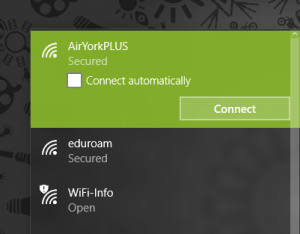
3. Enter your Passport York credentials as shown and click OK.
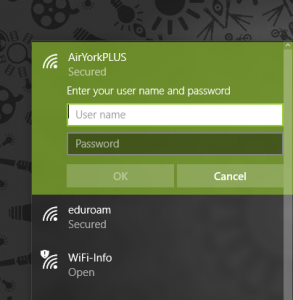
1. Click on the wireless icon (the globe or Wi-Fi symbol) in the taskbar located at the bottom right of your screen.

2. Select ‘AirYorkPLUS’ from the list of available networks and click Connect.
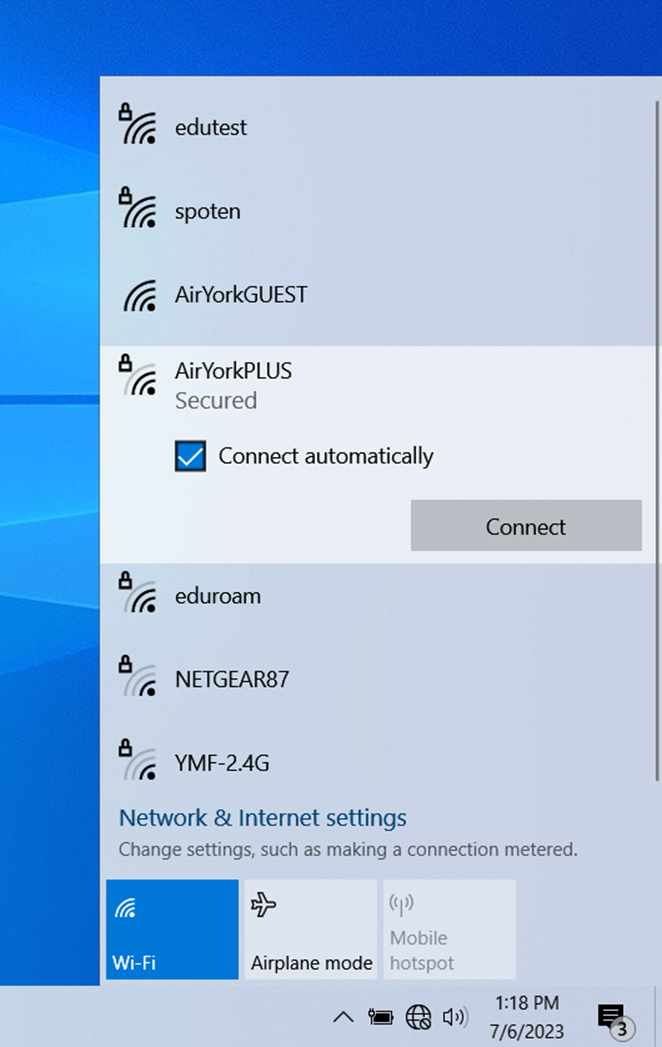
3. Enter your Passport York credentials as shown and click OK.
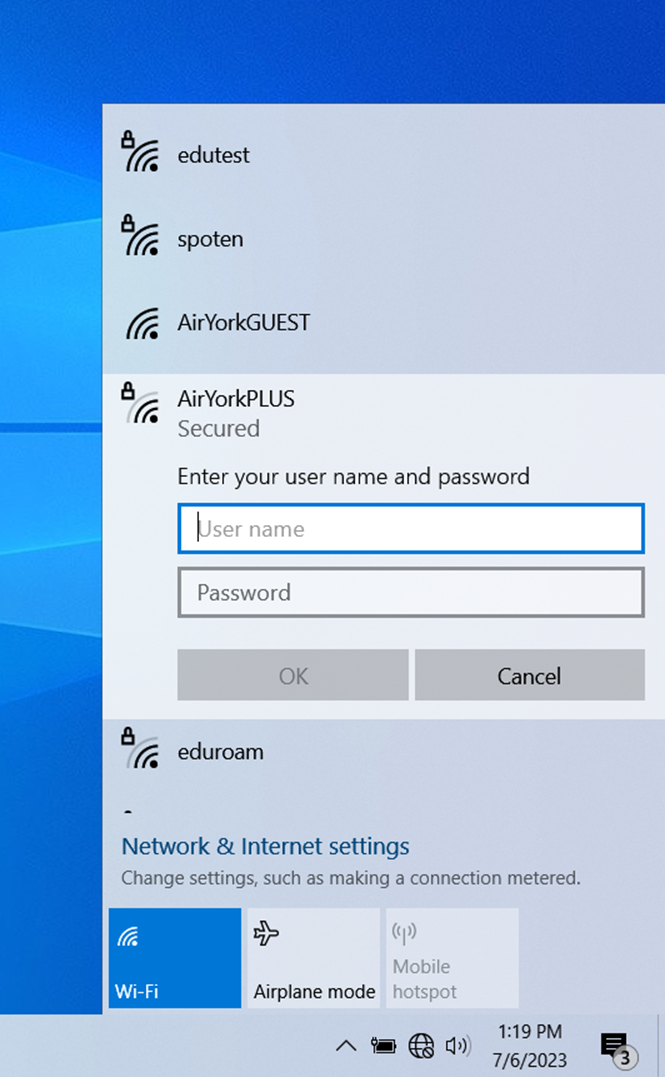
4. Click ‘Connect’ again to accept the certificate details.
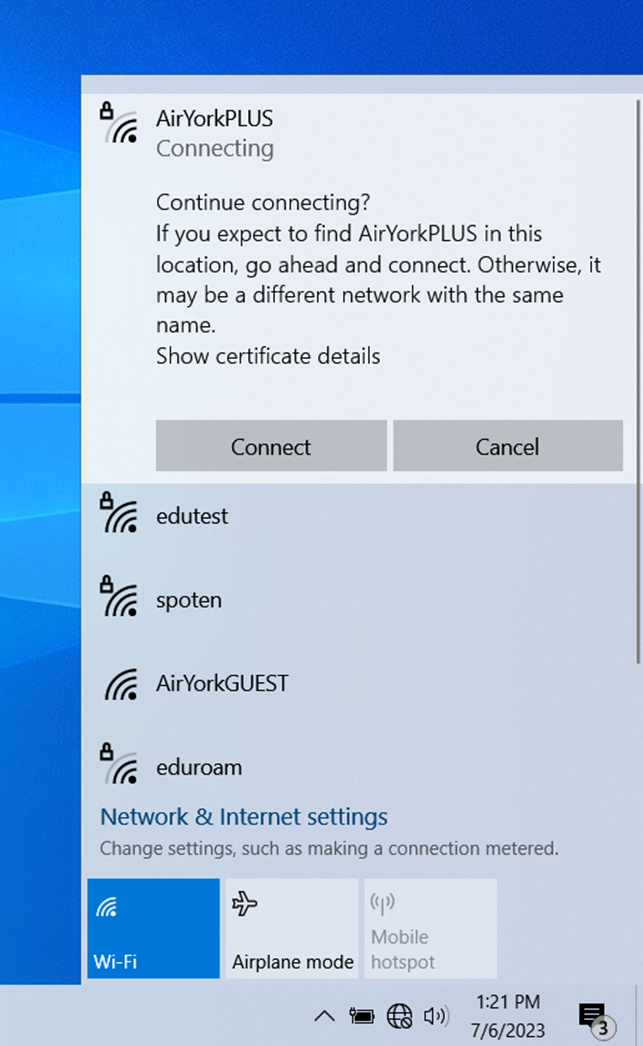
1. Click on the wireless icon in the task bar located at the top right corner of your screen and select AirYorkPLUS.
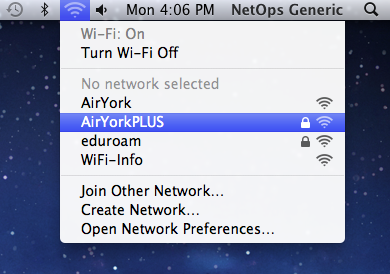
2. In the authentication window, enter your Passport York credentials and click Join.
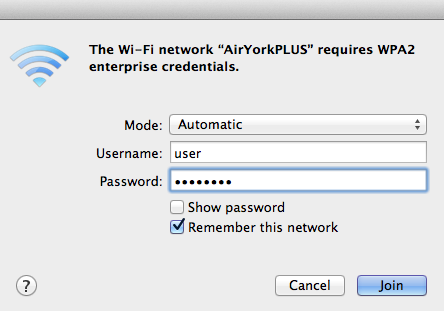
3. The Verify Certificate window will pop up, asking you to verify the authenticate.yorku.ca certificate for the AirYorkPLUS network is issued by GlobalSign Root CA; click Continue to connect.
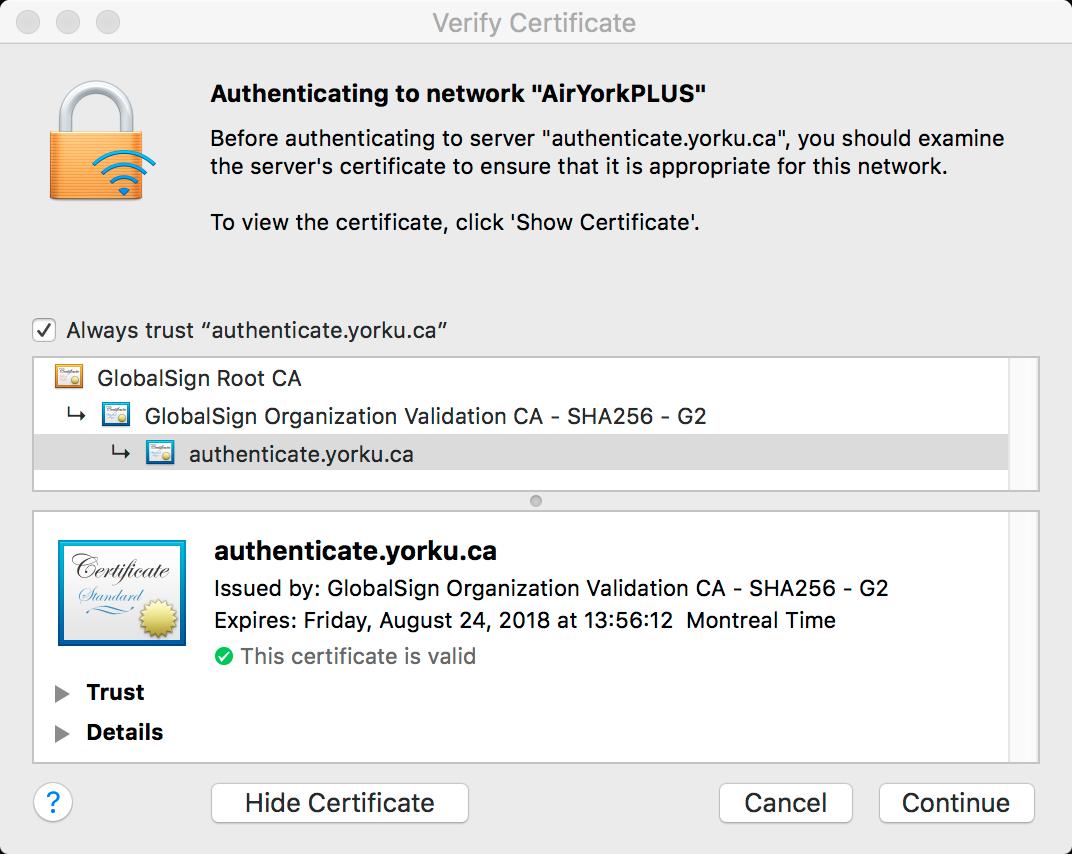
1. From your device home screen, activate the menu button and select Settings:
2. Click on Wi-Fi.
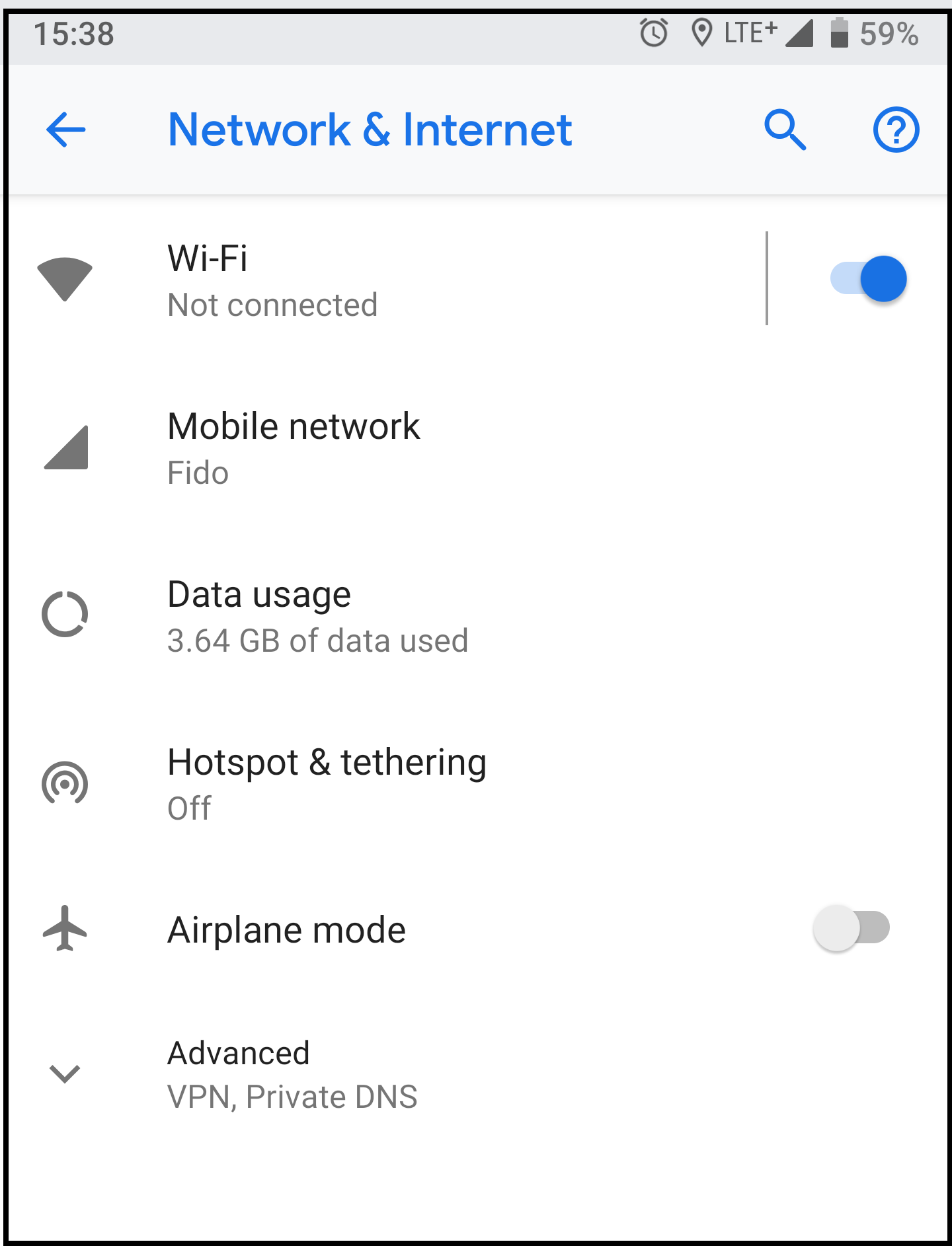
3. Select AirYorkPLUS from the list of Wi-Fi networks.
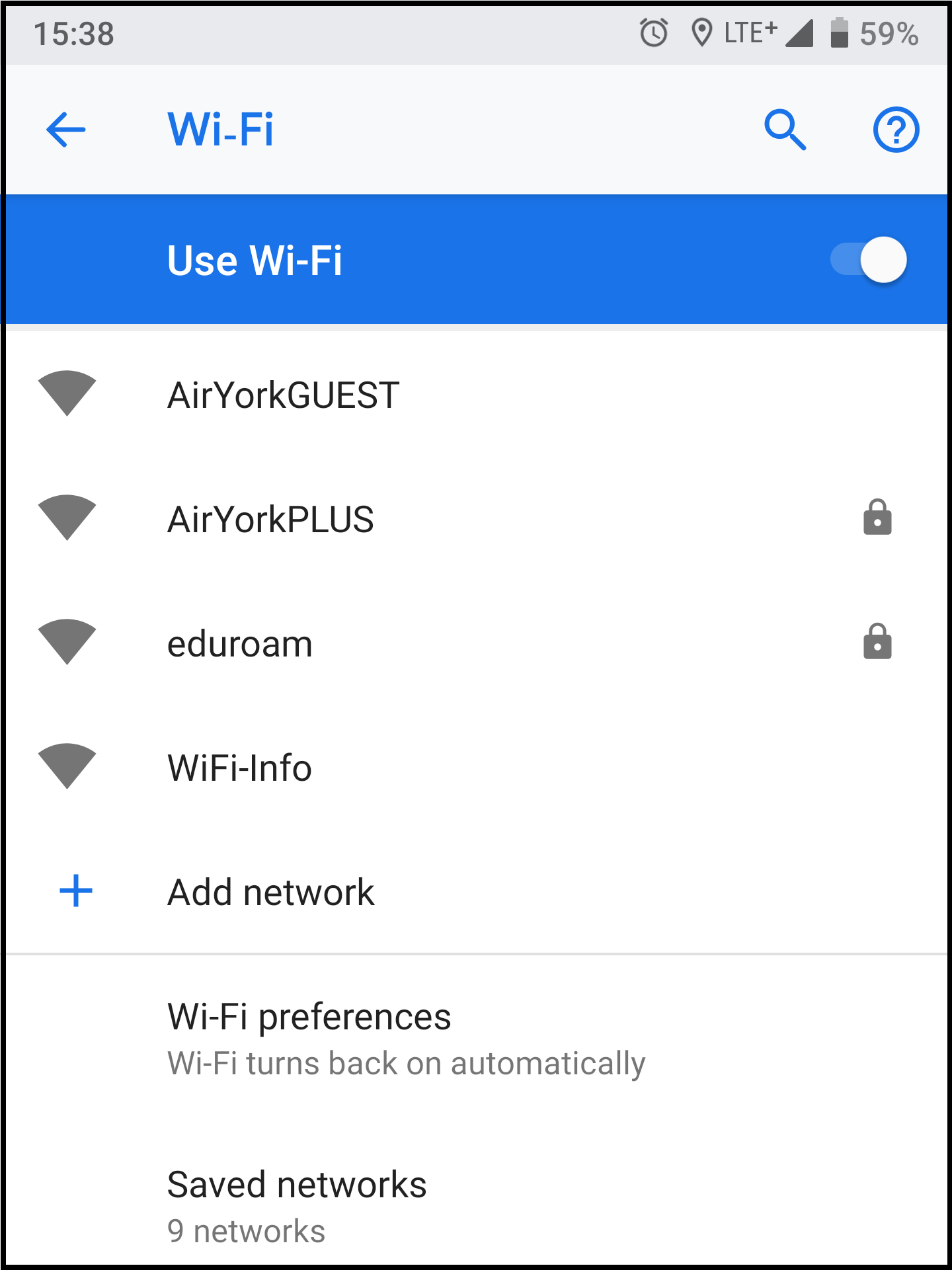
4. You may need to enter the follow information as shown below:
- EAP method: PEAP
- Phase 2 authentication: MSCHAPV2
- CA Certificate: Do not validate
- Domain: yorku.ca ( If you do not see the domain field then ignore )
- Identity: your Passport York Username
- Password: your Passport York account password
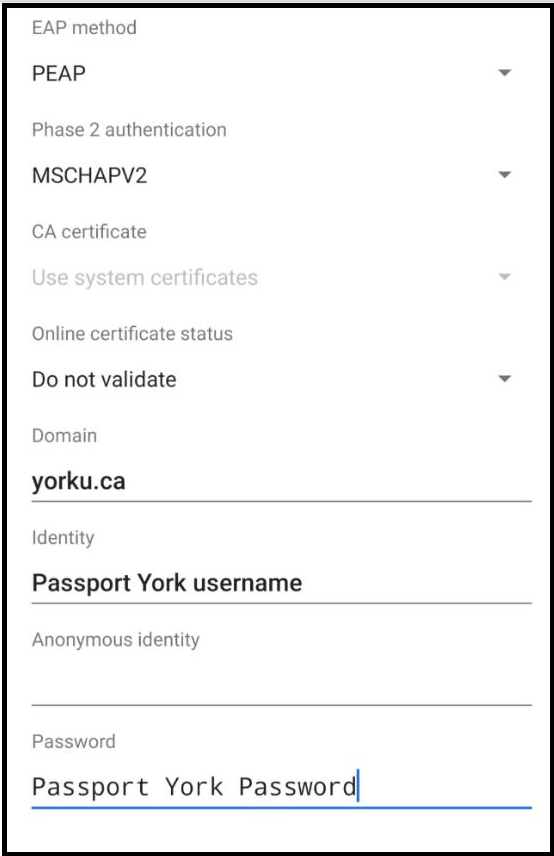
5. Click Connect to complete the process.
1. Select Settings, then Wi-Fi.
2. Select AirYorkPLUS from the list of available networks.
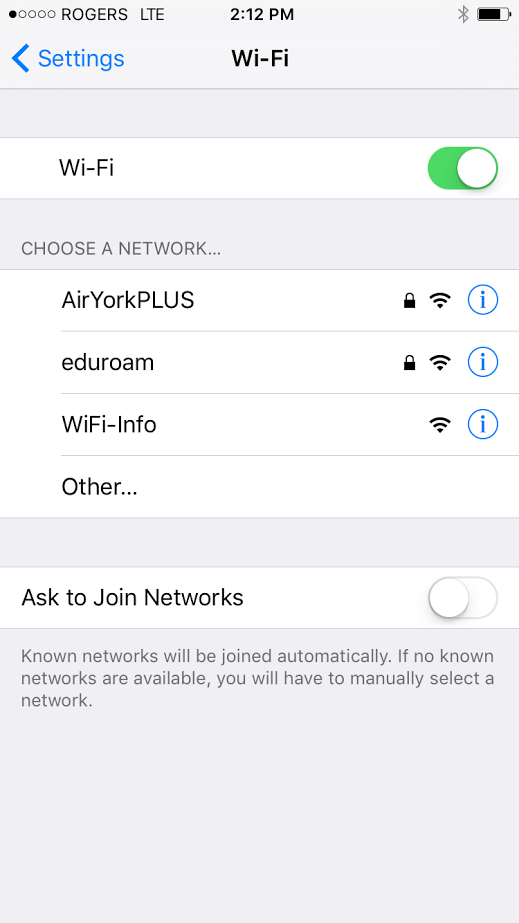
3. Enter your Passport York credentials and click Join.
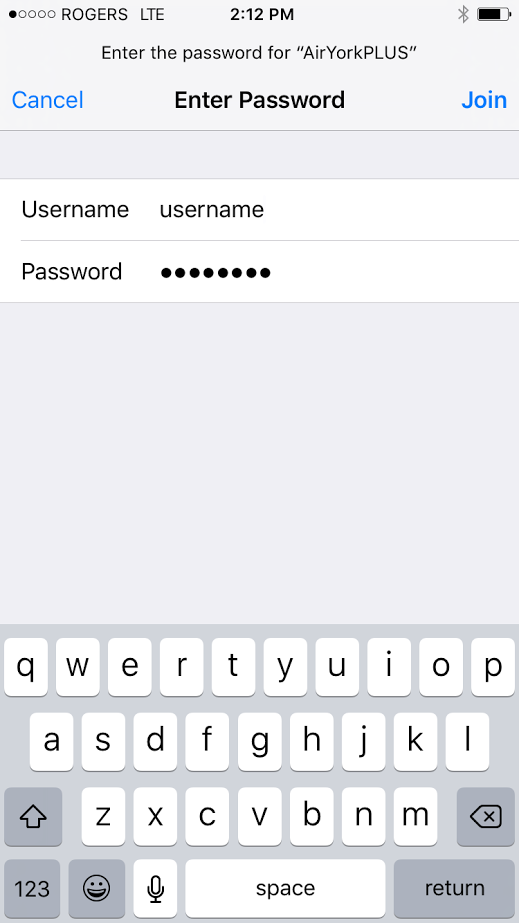
4. Verify the certificate is for authenticate.yorku.ca and is issued by GlobalSign Organization Validation CA; if so, select Accept.
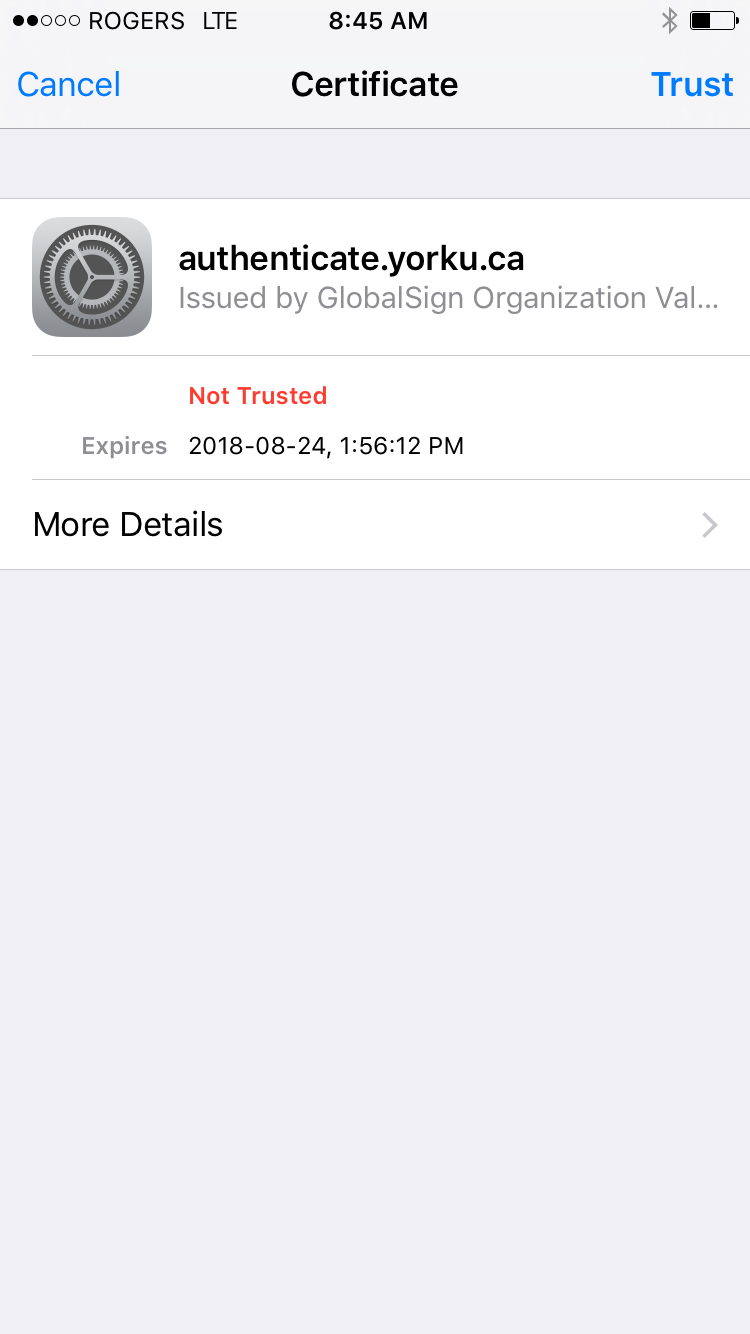
Overview:
eduroam provides wireless internet access to York community members and to visitors from eduroam-member institutions. eduroam provides improved security, performance, convenience and mobility. York community members connected to eduroam are provided the same service as if they were connected to AirYorkPLUS, and it is available in all the same locations as AirYorkPLUS. A Wi-Fi client device which is configured to use eduroam does not also require AirYorkPLUS.
**Please note that you will only have access to eduroam while you are an active York student. Once you leave or graduate, you will no longer be able to connect to eduroam-member institutions.
Who is it for?
At York, the eduroam service is available to visitors from an eduroam-participating institution. Current York University students may access eduroam while visiting other eduroam-participating institutions.
How do I access it?
- Check that the institution you will be visiting is an eduroam participant at eduroam institution list .
- Your login for eduroam your Passport York username followed by @yorku.ca, and your password.
- Configure your computer or wireless device & connect to eduroam wireless network:
1. Click on the wireless icon in the task bar located at the bottom right of your screen.

2. Select eduroam from the list of available networks and click Connect.
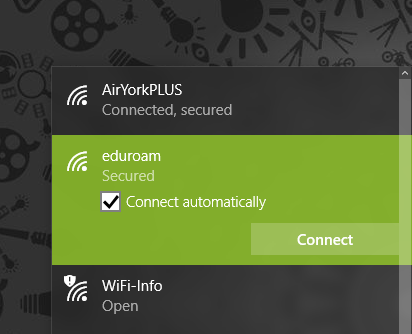
3. Enter your username in the form username@yorku.ca and your Passport York password and click OK.
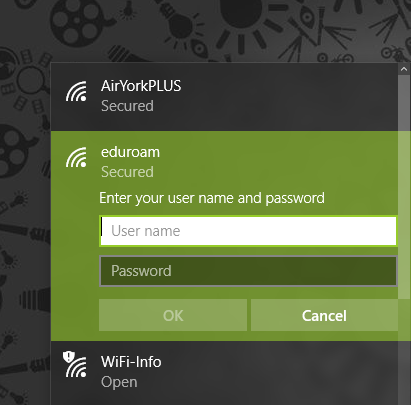
1. Click on the wireless icon in the task bar located at the top right corner of your screen and select eduroam.
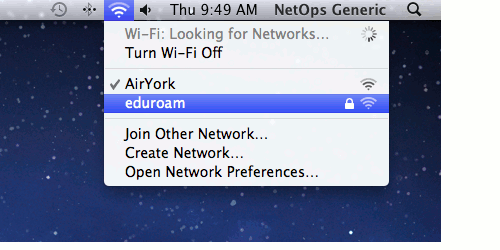
2. In the authentication window, enter the following and click Join:
- Username: PPYusername@yorku.ca
- Password: your FAS account password
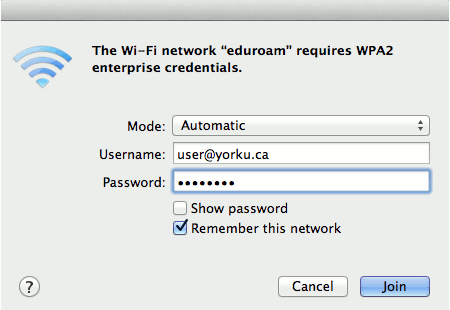
3. The Verify Certificate window will pop up, asking you to verify the certificate for server eduroam.yorku.ca and issued by GlobalSign Extended Validation CA. If so, click Continue.
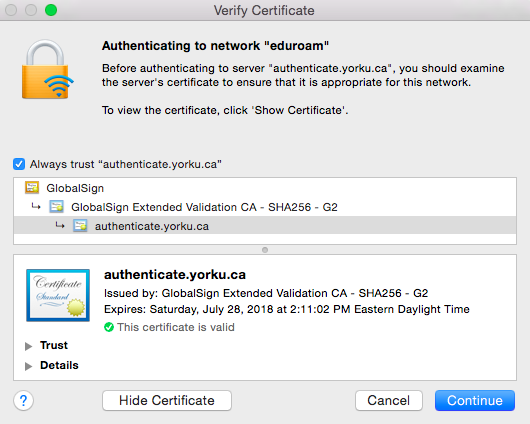
4. You will then be prompted for your machine's admin password in order to add this certificate to your Certificate Trust Settings; click Update Settings.
5. You should now be connected to the eduroam wireless network.
**Please note Android devices vary and the eduroam setup process may look slightly different depending on the device. Screen shots are dependent on the version of Android that the user has.
1. From the home screen search for Settings.

2. Find and tap on Settings (Fig.2) – you may have to swipe several screens to the right to find it.

3. In the Wireless & Networks section (Fig.3) select Wi-Fi
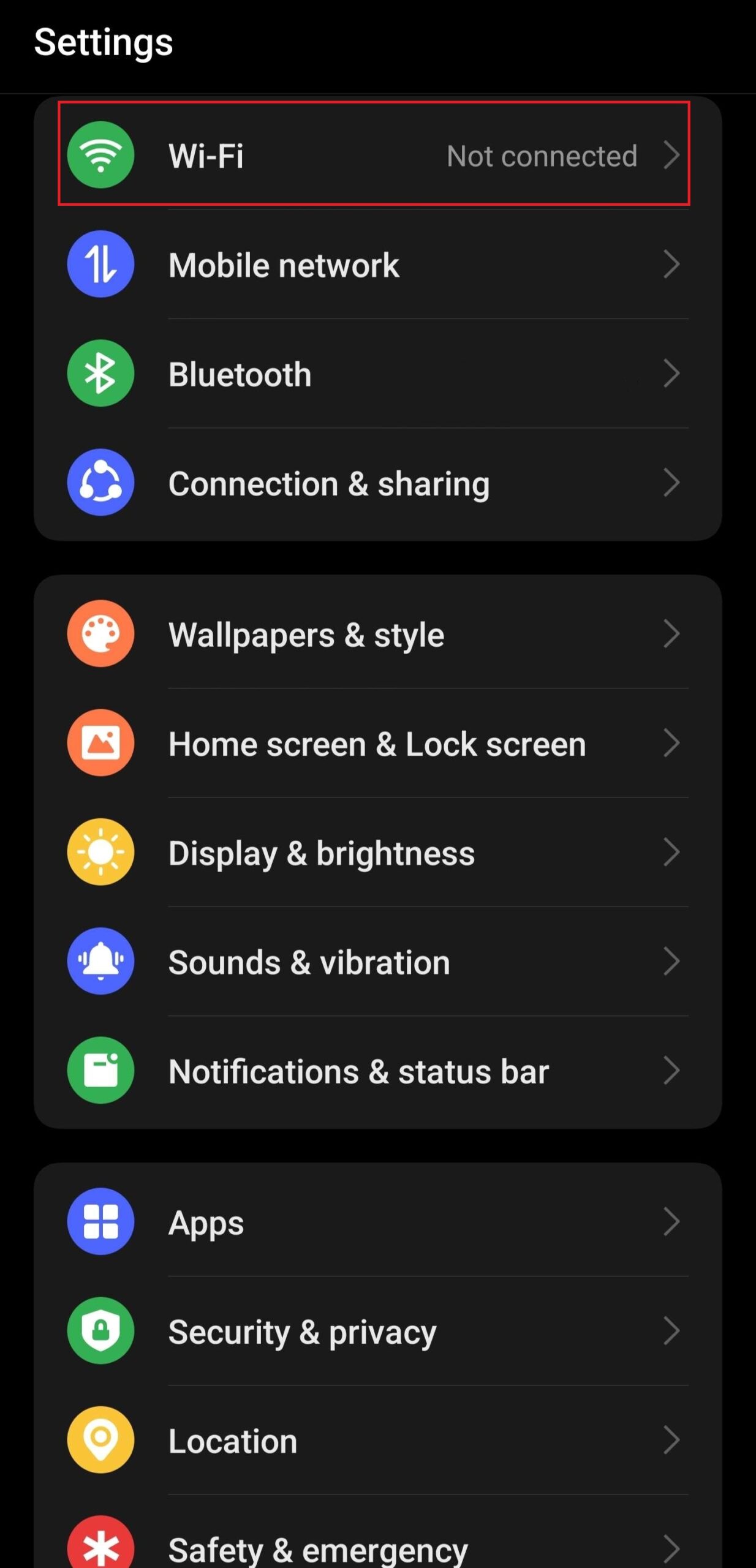
4. The Wi-Fi screen will open and display a list of available networks. Select eduroam
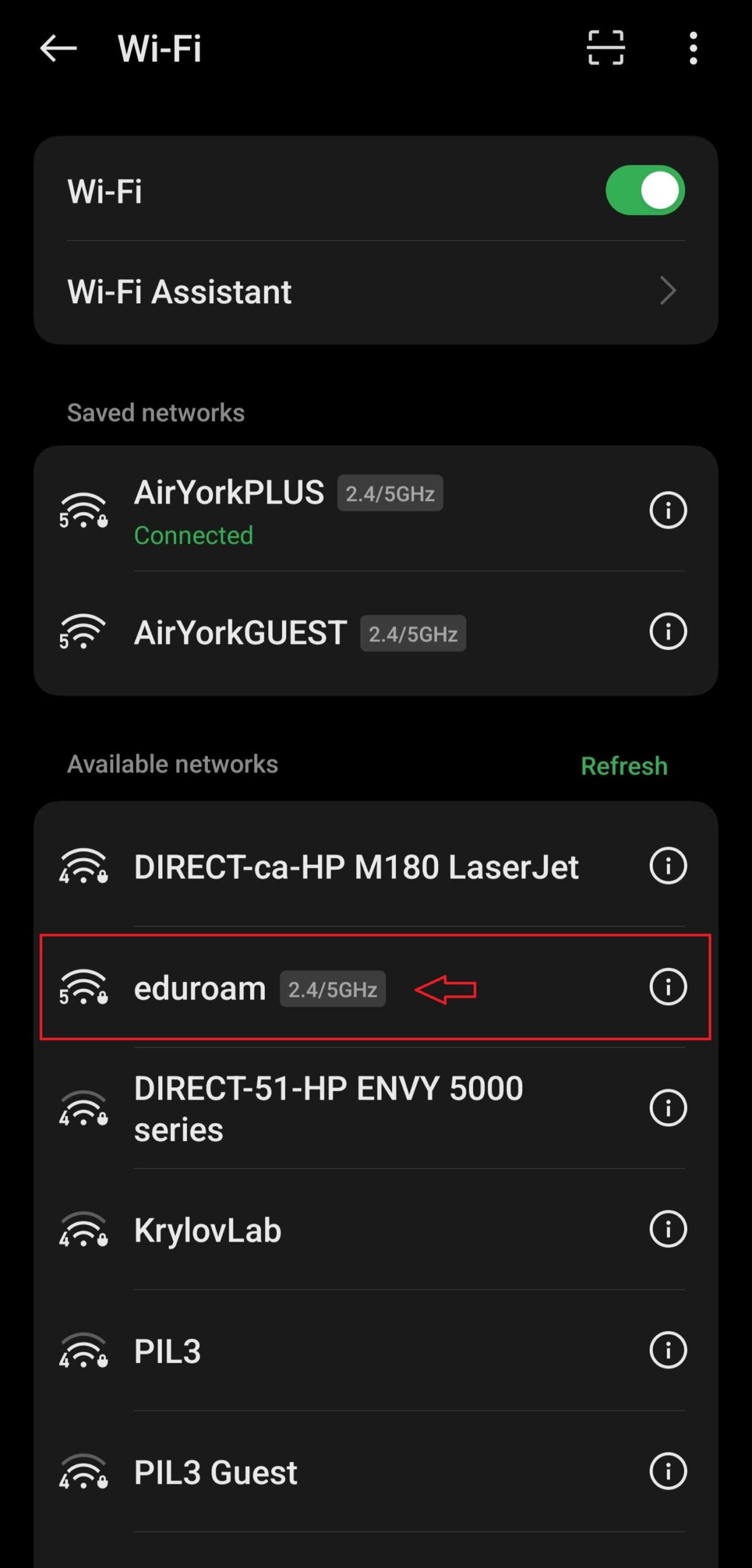
5. You will be prompted to sign in to the wireless network. Enter the following details in the settings menu (Fig.5):
EAP method: PEAP
Phase-2 authentication: MSCHAPV2
CA certificate: None
Domain: yorku.ca
Identity: Your Passport York username@yorku.ca
Anonymous identity: anonymous@yorku.ca
Password: your Passport York password
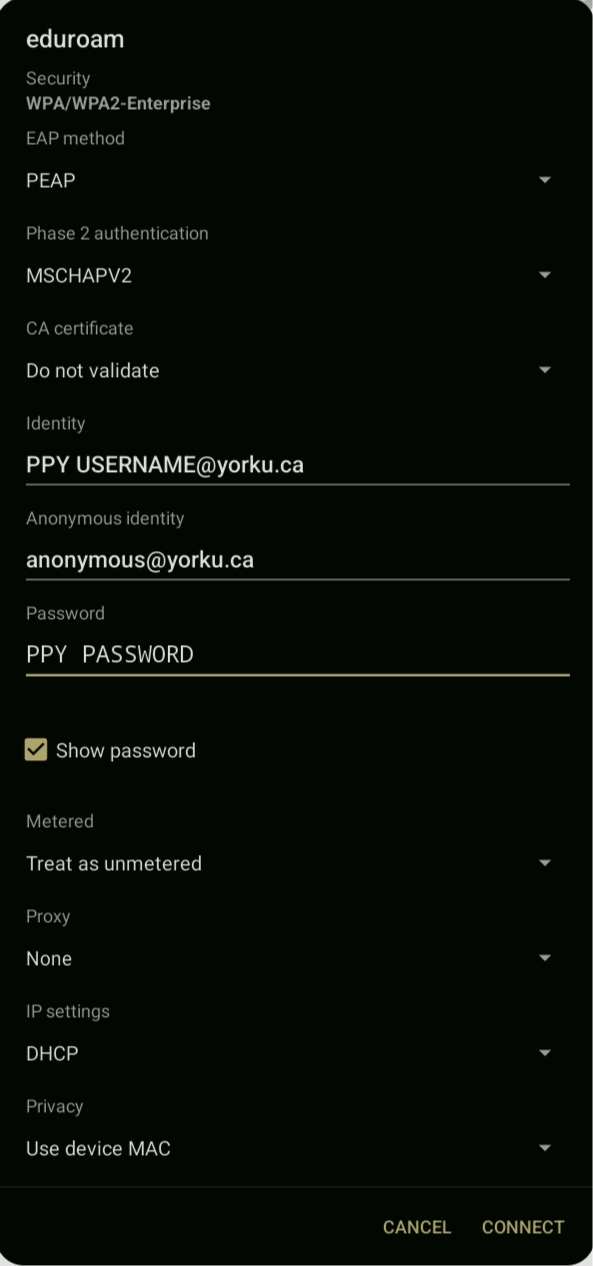
6. You should now be connected to the eduroam network.
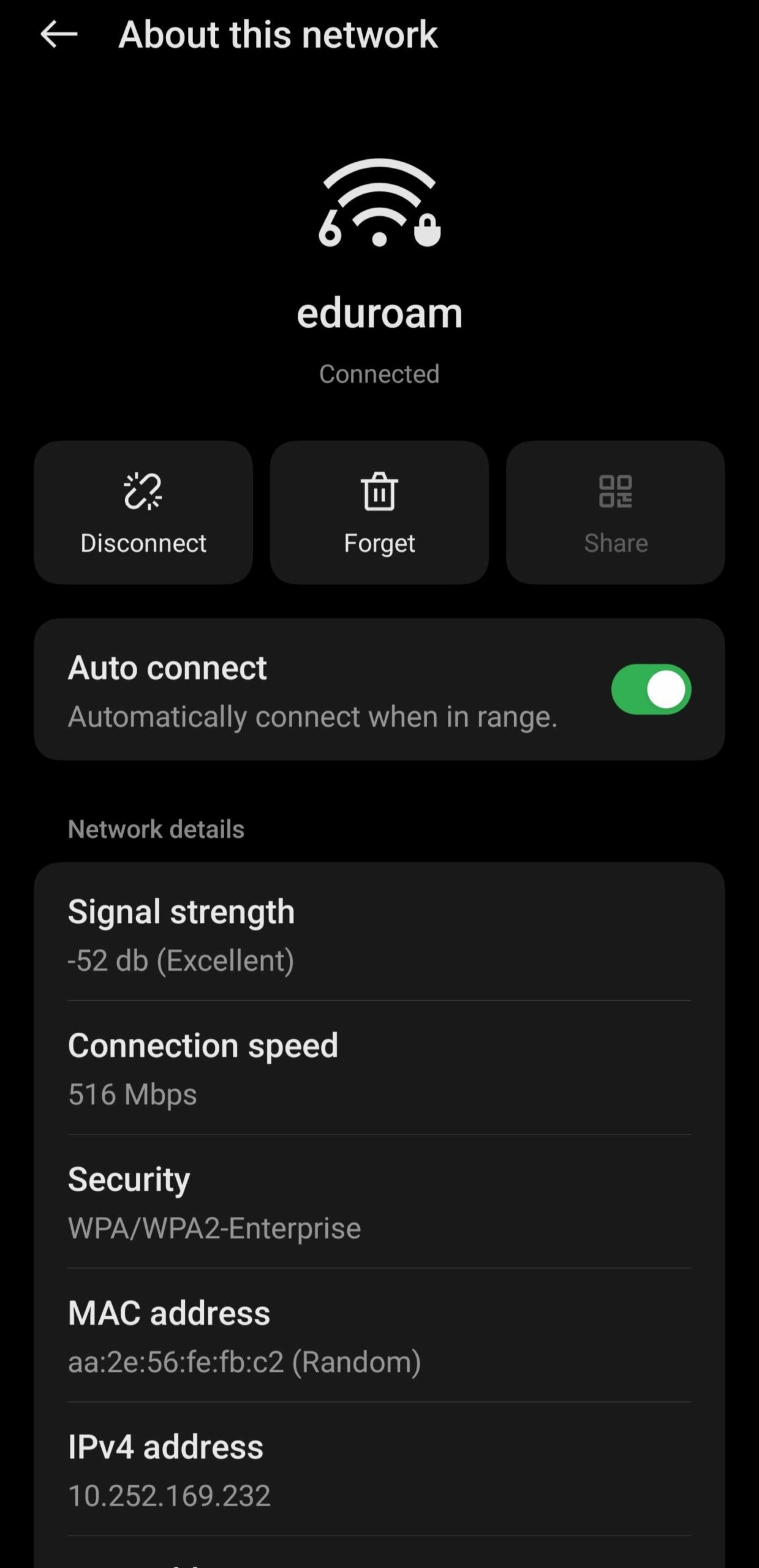
7. Press the Home key underneath the screen to exit Settings and return the main screen.
**Please note for a more stable connection users can change the field under Privacy heading to 'Use device MAC'. This setting may be available under Advanced Options.
1. Select Settings, then Wi-Fi.
2. Select eduroam.
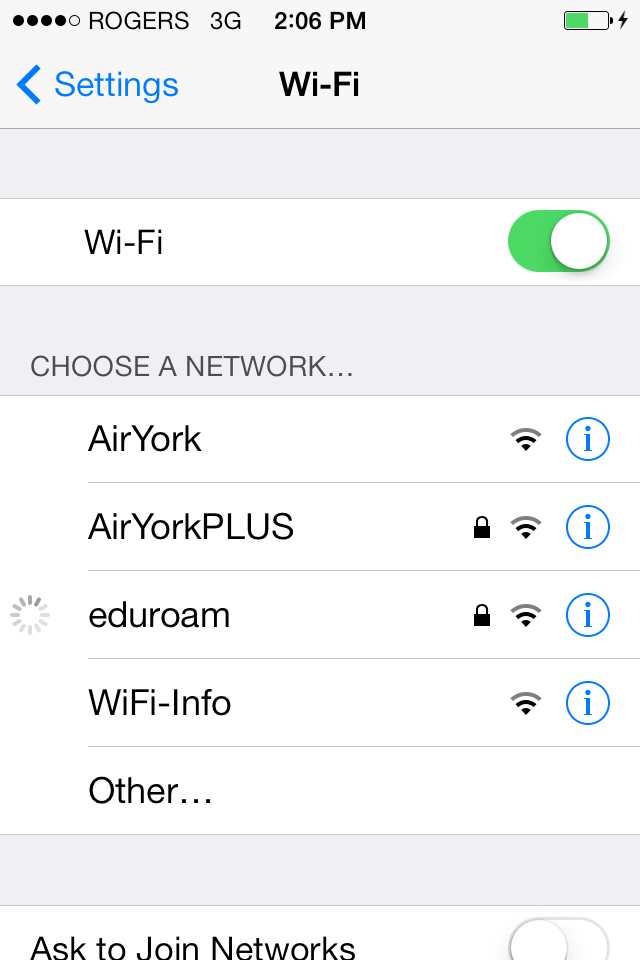
3. Enter the following, and click Join:
- Username: PPYUsername@yorku.ca
- Password: your Passport York password
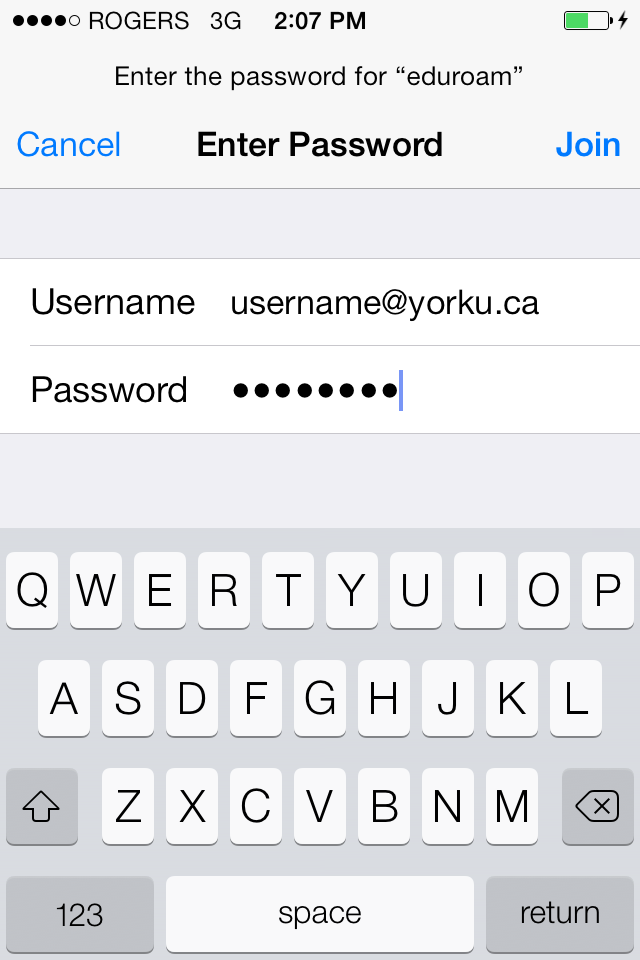
4. Verify the certificate is for eduroam.yorku.ca and is issued by GlobalSign Organization Validation CA. If so, select Accept.
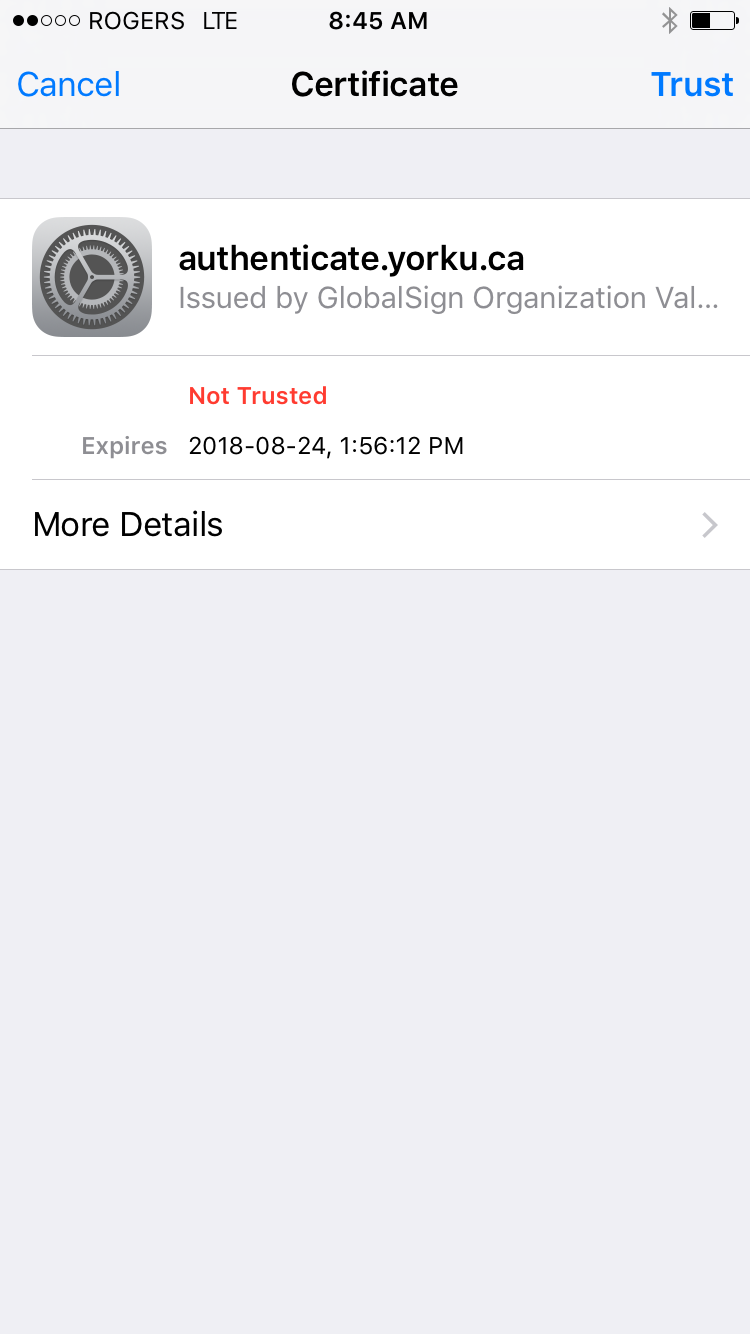
5. You should now be connected to the eduroam wireless network.
Overview:
AirYorkGUEST provides visitors to the University with Wi-Fi internet access. AirYorkGUEST also provides Wi-Fi network access to devices which do not have a web browser such as barcode scanners, and mobile printers. AirYorkGUEST is available in all the same locations as AirYorkPLUS.
- Maximum duration of a login session is 8 hours. Upon reaching this session time limit, the connection to the AirYorkGUEST network will be terminated without warning. However, you can register again for another 8 hour session.
- **Please note AirYorkGUEST cannot be used by the community that normally uses either eduroam or AirYorkPLUS.
How do I access it?
1. In the list of available wireless networks, select AirYorkGUEST.
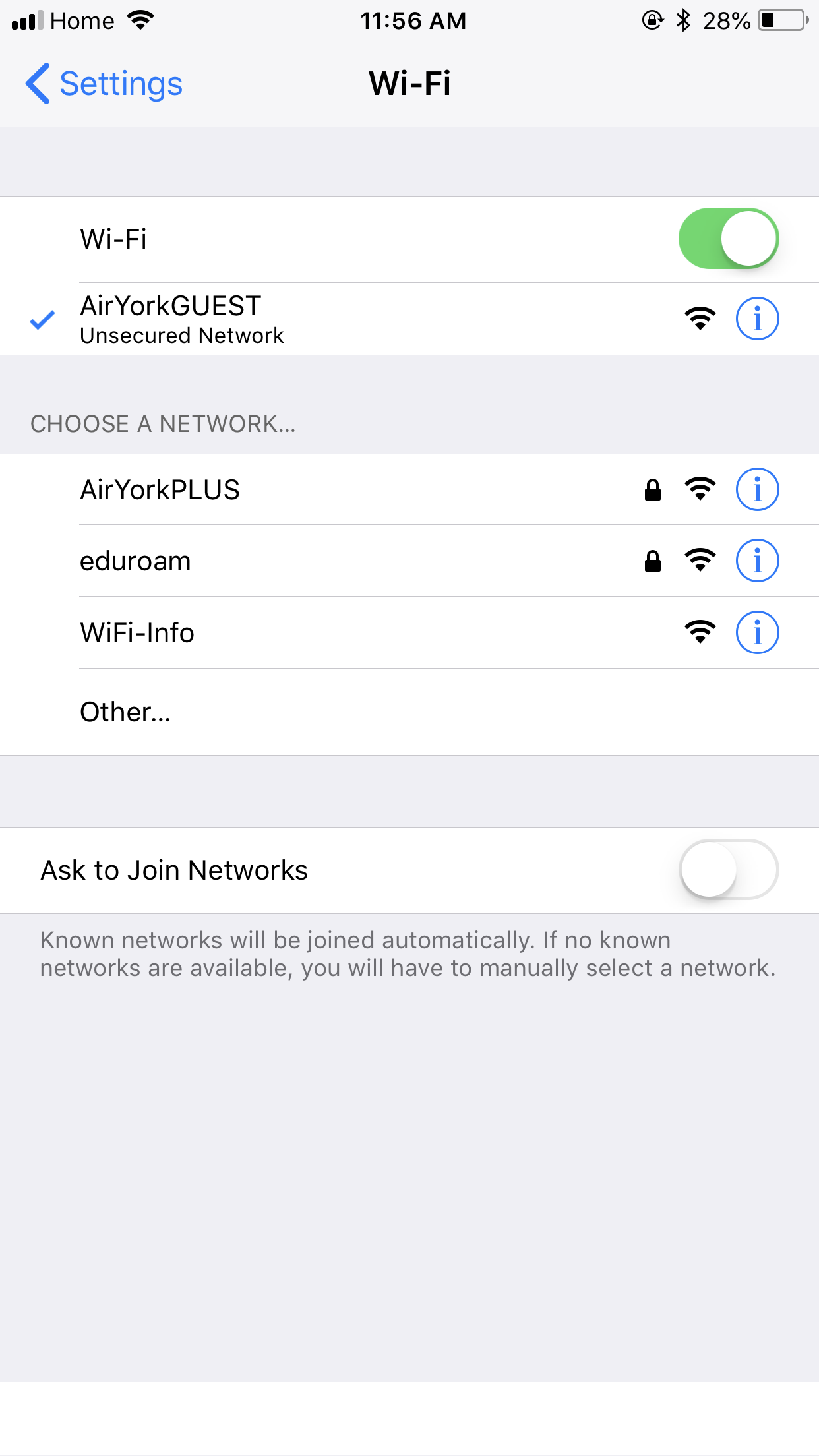
2. Once you get redirected to the AirYorkGUEST splash screen, enter your information.
3. You will be redirected to the AirYorkGUEST Service Registration Page. Select an authentication method - email or sms and accept the terms and conditions.
**Please note that if you provide your email address then you will get 10 mins of internet access to check your mail and click on the validation link.
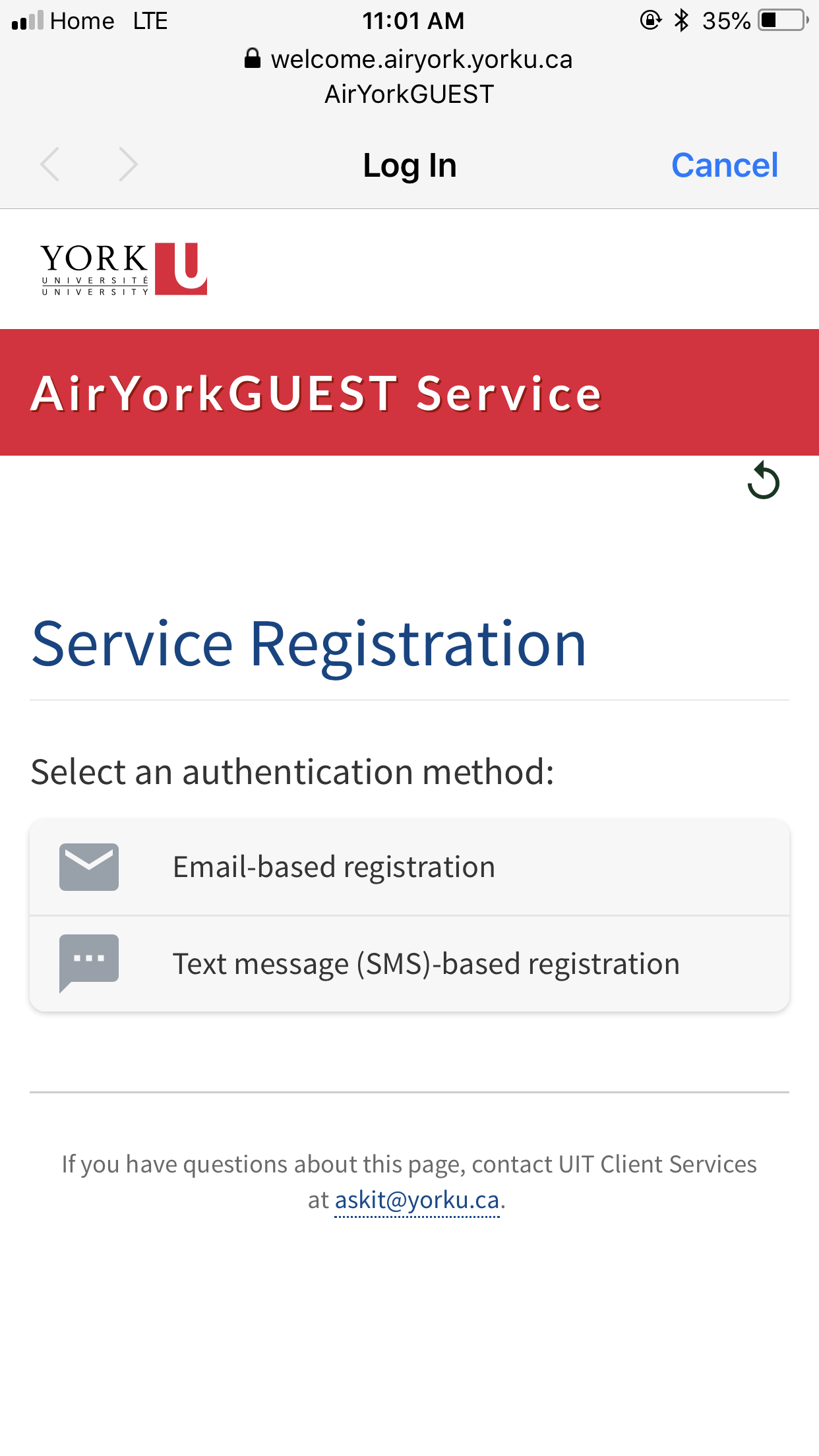
4. Receive and confirm the the verification message and start using the Internet.
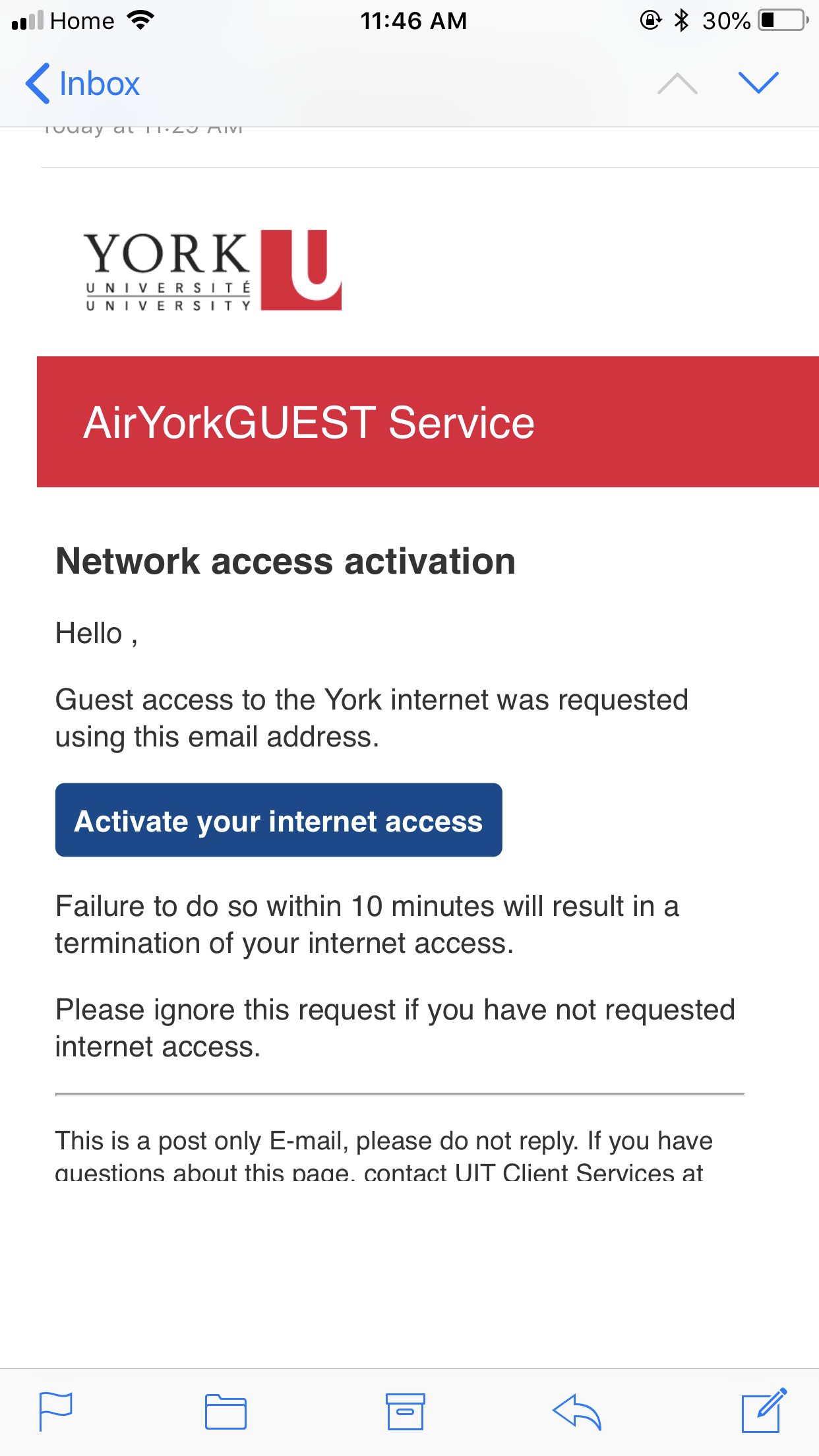
5. Click on the validation link on the email you received to start accessing the internet or enter the verification code you received via SMS in the Service Registration Website.
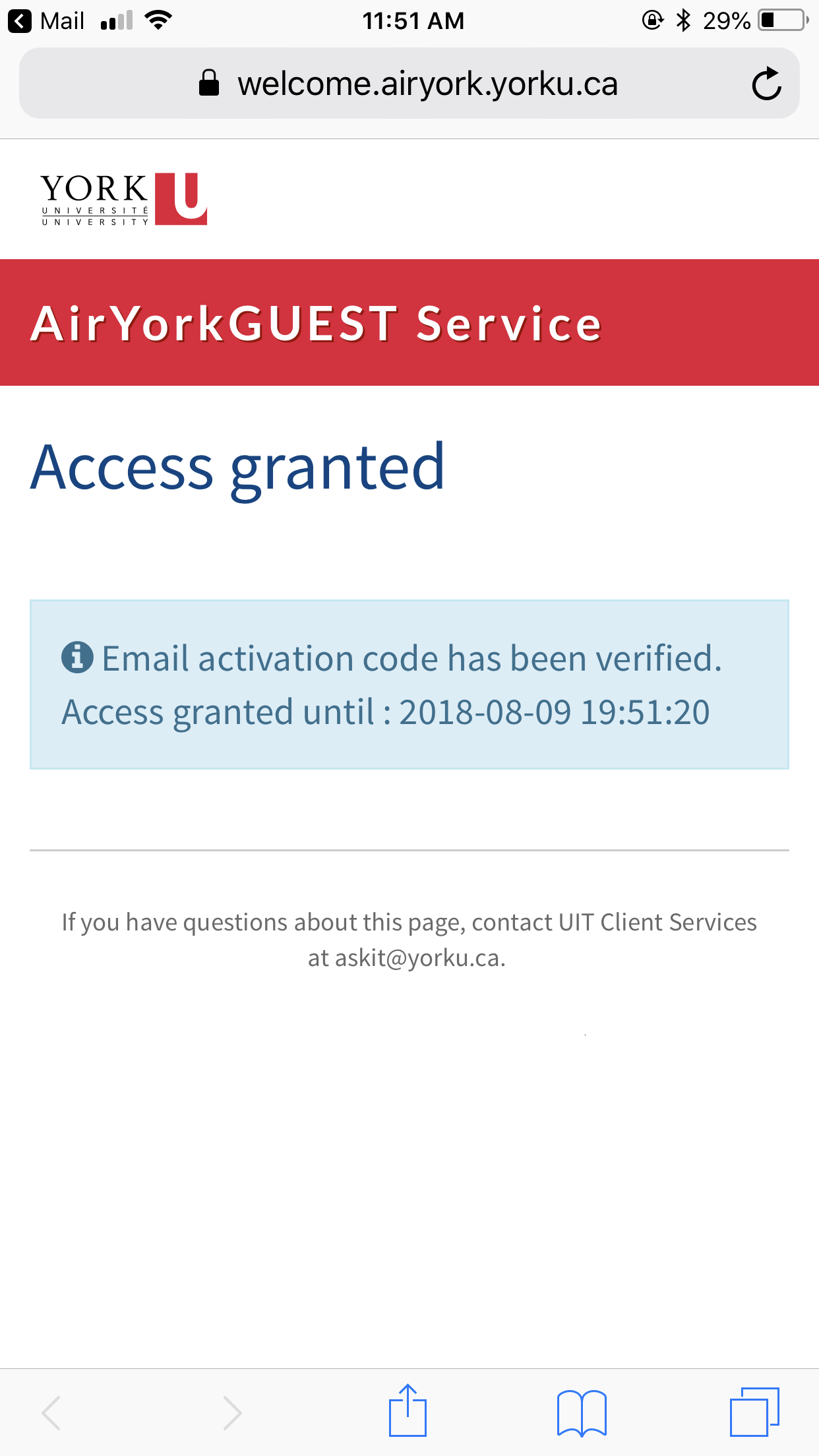
Overview:
Wireless and wired internet service is available in all residences along with VoIP telephone service at York University Keele and Glendon Campuses. Please see the Residence Internet Subscriber Agreement below:
All subscribers of York University provided residence internet service must indicate their acceptance of this agreement for network service to be provided. Violations of this agreement will result in the offending subscriber system being disconnected from the network with or without prior notice. Restoration of service is dependent on the subscriber's compliance with this agreement and is at the discretion of University Information Technology. Violations of this agreement which also violate other York University policy or law may also result in loss of access privileges, University disciplinary action, and/or legal action.
Terms and Conditions:
- Responsibility for Use: Individual subscribers are solely responsible for all use of their residence internet connection and ensuring that it is not used in violation of this and other relevant University policy or law, including the Senate Policy on Computing and Information Technology Systems and associated Network Security and Management Guidelines.
- Contact Information: residence internet is operated by University Information Technology (UIT). It is the subscriber's responsibility to submit accurate contact information to UIT. Failure to do so may result in termination of service without warning.
- Respect of Copyright: Distribution or downloading of copyrighted materials in violation of copyright law is prohibited.
- Client Computer Security Verification: Clients are required to maintain their computer in a secure fashion, at minimum ensuring all critical security updates are applied, and the system is free of viruses and other malicious software. UIT provides anti-virus software free of charge to students of York University. Clients may be required to run a verification agent/program on their system to verify appropriate security settings are in place, critical updates are applied, and UIT-provided anti-virus software is active and updated.
- Usage Limits: UIT reserves the right o limit the amount of residence internet upload/download usage.
Prohibited Use:
The following points clarify or are in addition to the restrictions listed in the Network Security and Management Guidelines. Violation of any of the following prohibited uses may result in suspension or termination of the subscriber's residence internet connection.
- Network Abuse: Attempting to interfere with the normal operation of networks and systems within or external to the University is prohibited. This includes scanning, monitoring, interception, impersonation, or modification of systems and data without authorization.
- Commercial Use: Use of residence internet connections to host services for commercial purposes is prohibited.
- Subscriber Use Only: The residence internet connection is for the use of the individual subscriber only. Extending the service to others by any means (network hub, connection sharing, wireless access point, etc.) is prohibited except where expressly permitted.
- Unsolicited Bulk E-mail (Spam): Use of the residence internet connection to send unsolicited bulk e-mail is prohibited.
- IP Addresses and Domain Names: All subscribers will be automatically assigned a dynamic IP address and domain name by the network - attempting to use a different IP than the one assigned is prohibited. Arranging for an external non-"yorku.ca" domain name to refer to a residence internet IP address is prohibited.
- Third-party Use: Use of software which allows others to use the residence internet resources available to the subscriber, such as proxy servers, e-mail relaying, remote control of the computer, or other related function not directly initiated by the subscriber is prohibited.
- Wireless Network Services: Operation of DNS or DHCP services on any network interface connected to the residence internet service is prohibited.
Other Conditions:
- Network Traffic: University Information Technology (UIT) will control inbound and outbound Internet traffic and the types and flow rates of traffic permitted. Decisions about the permitted types of traffic will be based on the business and academic goals of the University and the security exposure involved.
- Network Monitoring: UIT will monitor network traffic as necessary and appropriate to detect unauthorized activity or intrusion attempts and ensure efficient operation. All monitoring will be carried out in compliance with the University Policy on Computing and Information Technology Facilities.
- Security Auditing: UIT, or its designee, is authorized to perform a security audit of any device connected to the residence internet network service at any time. Subscribers will be notified via the contact information provided to resolve any identified vulnerabilities. UIT reserves the right to disable network access to any Subscriber with an identified security vulnerability until the vulnerability has been resolved.
- Incident Response: Subscribers are requested to report suspected system security compromises or network abuse via e-mail to abuse@yorku.ca, or to UIT Client Services.
- Prohibited/Blocked Network Services or Servers: Residence Network Subscribers are prohibited from running the following types of servers or services on computers connected to the Residence Network:
- Remote login services (Windows Remote Desktop, PCanywhere, Dameware, telnet, RSH, SSH, etc)
- File transfer servers (web, FTP, NFS, SMB/CIFS, etc.)
- IRC servers
- Mail servers (SMTP)
- Permitted use of Routers: Subscribers are allocated one IP address. The use of hubs or switches to extend the network is prohibited. Providing network service to computers located outside of the designated Subscriber's Undergraduate Residence Room or York Apartment Unit is prohibited. Extending the network access using a wireless network is prohibited. Users who have more than one computer will need to provide a 'broadband router' (sometimes referred to as a Cable/DSL router or home router), the use of a consumer grade 'broadband router' is permitted as long as it does not interfere with the normal operations of the network.
Modifications:
York University reserves the right to modify or change this agreement without prior notice or consent.
Undergraduate residences
(Bethune, Calumet, Stong, Vanier, Founders, Winters, Tatham Hall, Pond, Hilliard, and Wood Residences)
- Students living in the residences have access to wired internet
- No registration is required
- No configuration is required - it works with normal default settings of DHCP, auto negotiate speed and duplex.
**Please note this Internet service functions with typical default automatic settings, which is similar to what your regular Internet service provider offers (i.e. your ISP at home). If our technician confirms the service is working, we can only make best efforts to assist with personal device settings but there is no promise of a solution if your device issues persist despite our attempts at making setting changes/adjustments (or if there's a virus, malware, driver, software/driver update problem, etc. with your device).
How Do I Connect?
Please follow instructions below that pertain to your residence:
- Wired connectivity is available by plugging into any Port (LAN2 & LAN3) using a network cable
- Depending on which white box you have in your residence, see below pictures for details
- The Green Port LAN4 or LAN1 ( depending on the white box in your residence ) is used for VoIP Phone
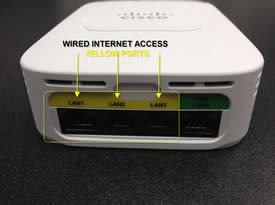
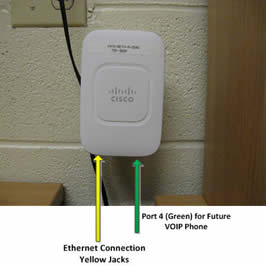
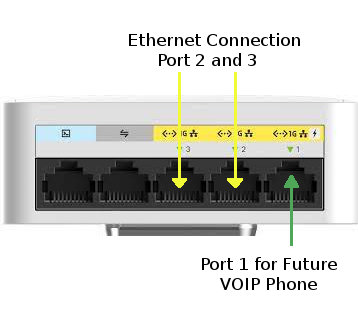
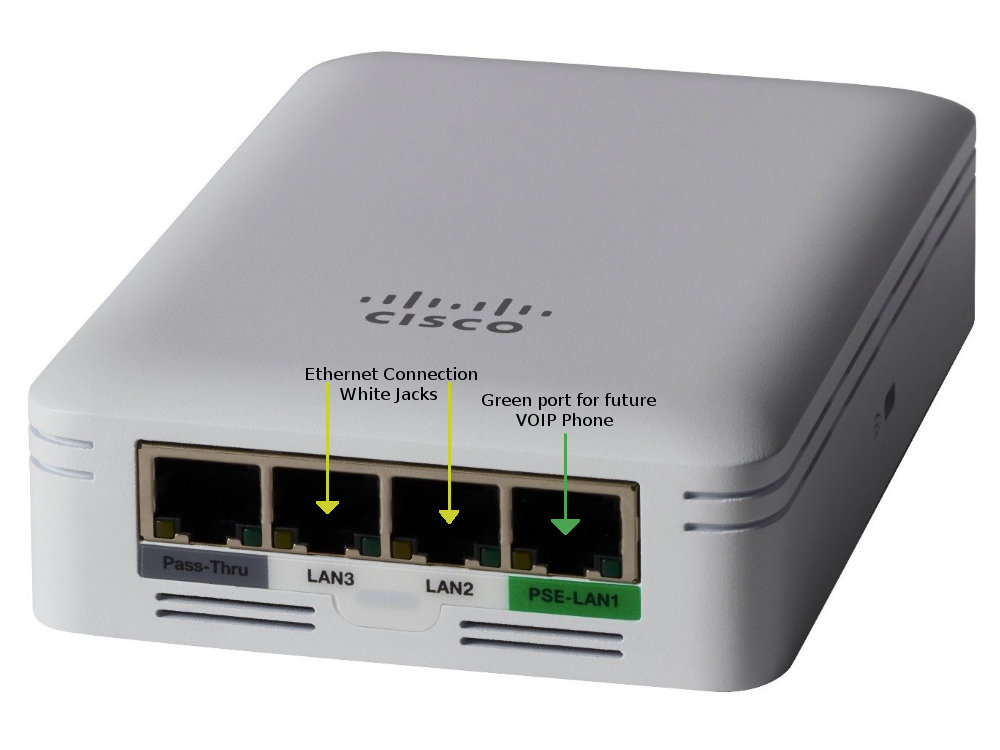
- These Data Jacks are used with a Ethernet Cable for wired access connectivity.
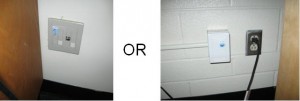
- The black arrow indicates the phone jack and the blue jack indicates the data jack used for wired access using a Ethernet Cable
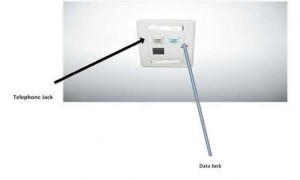
**Please note personal routers are not permitted
Use of routers (WiFi/Wireless or Wired) is NOT PERMITTED. Being caught using a Router within the residences will result with your in-room Ethernet port being disabled. Please see the Residence Internet Subscriber Agreement for more details.
Residents with active Passport York accounts should use VoIP Request Form for VoIP phone service and billing inquiries.
Monthly Service Charge: $21.50/month plus HST.
Activation/Move Fee: $43.50
Billing:
Charges are posted to your Student Account following the month in which they were incurred. For example, your charge for the month of January will appear on your Student Account in February.
VoIP phones are installed by a UIT technician. They remain the property of York University. When you terminate service, please submit a termination request using the Service Request Form. We will contact you to arrange the return of the VoIP phone. A charge of $100.00 will be applied to your Student Account for a missing or damaged phone. (Monthly charges will continue to be billed to your account until we receive notice from you to terminate your service and the phone is returned so please remember to cancel your service if you move out.)
Wi-Fi MAC address registration for your Wi-Fi device (smart device) in residence:
- Wi-Fi devices such as Smart TVs, gaming consoles, and other smart home media devices (e.g. Amazon Echo, Google Home, Nest, smart speakers, smart thermostats, etc.) can receive wireless access by completing the MAC Address Registration process (see below)
Who can use this Wi-Fi MAC address registration service?
- Students residing in AirYorkGUEST Wi-Fi supported residences are permitted to use this service
What type of devices can use this service?
- For any Wi-Fi device that does not support Passport York login (devices such as Gaming Consoles, Set-top TV boxes and Smart TVs)
- Please note that the use of personal Wi-Fi devices in residence is allowed, but any issues or problems that may arise from the use of these devices will not be supported
What type of devices cannot use this service?
- Any device that is capable of using Passport York login cannot use this service (smartphone, tablet, laptops or desktop computers)
- **Please note routers, hubs, Wi-Fi Extenders or network switches are not permitted. Registered devices not meeting the above criteria may be removed from the service by IT staff at any time
Requirements:
- A device's wireless MAC address is used for connecting to the network. In order to register the device you will need to locate the wireless MAC address or wireless physical address. This address is typically located physically on the device near the serial number or can be found in the menu system (i.e system information, about menu, etc.). The wireless MAC address is formatted in six groups of two hexadecimal digits. The address may be formatted like aa:bb:cc:11:22:33 or aa-bb-cc-11-22-33
Yearly device MAC address removal(s) and renewal(s):
- Personal device registration expires annually (August 1st) and registration must be renewed to continue service. Devices are automatically removed from the registration database unless they are renewed
Limitations to the devices we can support:
- Please be advised that personal Wi-Fi devices, such as smart speakers, smart thermostats, and other similar devices are not supported. This includes devices such as Amazon Echo, Google Home, Nest, and others. These devices are considered personal items and are not part of the university's technology infrastructure. We recommend that you seek assistance from the device's manufacturer or retailer if you experience any technical difficulties with your personal Wi-Fi device.
How do I get a device registered?
- After you've read the above information of this section, if you do need to register a smart device please complete the Service Request Form
York apartments
(Assiniboine, Atkinson, & Passy Crescent buildings)
- Students living in the residences have access to wired internet.
- No registration is required.
- No configuration is required - it works with normal default settings of DHCP, auto negotiate speed and duplex.
**Please note that this Internet service functions with typical default automatic settings, which is similar to what your regular Internet service provider offers (i.e. your ISP at home). If our technician confirms the service is working, we can only make best efforts to assist with personal device settings but there is no promise of a solution if your device issues persist despite our attempts at making setting changes/adjustments (or if there's a virus, malware, driver, software/driver update problem, etc. with your device).
How do I connect?
- Wired connectivity is available by plugging into any Port (LAN2 & LAN3) using a network cable.
- Depending on which white box you have in your residence, see below pictures for details.
- The Green Port LAN4 or LAN1 ( depending on the white box in your residence ) is used for VoIP Phone




IMPORTANT: PERSONAL ROUTERS NOT PERMITTED
Use of ROUTERS (WiFi/Wireless or Wired) is NOT PERMITTED is NOT PERMITTED. Being caught using a Router within the residences will result with your in-room Ethernet port being Disabled. Please see the Residence Internet Subscriber Agreement for more details.
Residents with active Passport York accounts should use VoIP Request Form for VoIP phone service and billing inquiries.
Monthly Service Charge: $21.50/month plus HST.
Activation/Move Fee: $43.50
BILLING:
Charges are posted to your Student Account following the month in which they were incurred. For example, your charge for the month of January will appear on your Student Account in February.
VoIP phones are installed by a UIT technician. They remain the property of York University. When you terminate service, please submit a termination request using the Service Request Form. We will contact you to arrange the return of the VoIP phone. A charge of $100.00 will be applied to your Student Account for a missing or damaged phone. (Monthly charges will continue to be billed to your account until we receive notice from you to terminate your service and the phone is returned so please remember to cancel your service if you move out.)
Wi-Fi MAC address registration for your Wi-Fi device (smart device) in residence:
- Wi-Fi devices such as Smart TVs, gaming consoles, and other smart home media devices (e.g. Amazon Echo, Google Home, Nest, smart speakers, smart thermostats, etc.) can receive wireless access by completing the MAC Address Registration process (see below).
Who can use this Wi-Fi MAC address registration service?
- Students residing in AirYorkGUEST Wi-Fi supported residences are permitted to use this service.
What type of devices can use this service?
- For any Wi-Fi device that dose not support Passport York login: devices such as Gaming Consoles, Set-top TV boxes and Smart TVs.
- Please note that the use of personal Wi-Fi devices in residence is allowed, but any issues or problems that may arise from the use of these devices will not be supported.
What type of devices cannot use this service?
- Any device that is capable of using Passport York login cannot use this service: smartphone, tablet, laptops or desktop computers.
- IMPORTANT: Routers, hubs, Wi-Fi Extenders or network switches are not permitted. Registered devices not meeting the above criteria may be removed from the service by IT staff at any time.
Requirements:
- A device's wireless MAC address is used for connecting to the network. In order to register the device you will need to locate the wireless MAC address or wireless physical address. This address is typically located physically on the device near the serial number or can be found in the menu system (i.e system information, about menu, etc.). The wireless MAC address is formatted in six groups of two hexadecimal digits. The address may be formatted like aa:bb:cc:11:22:33 or aa-bb-cc-11-22-33.
Yearly device MAC address removal(s) and renewal(s):
- Personal device registration expires annually (August 1st) and registration must be renewed to continue service. Devices are automatically removed from the registration database unless they are renewed.
Limitations to the devices we can support:
- Please be advised that personal Wi-Fi devices, such as smart speakers, smart thermostats, and other similar devices are not supported. This includes devices such as Amazon Echo, Google Home, Nest, and others. These devices are considered personal items and are not part of the university's technology infrastructure. We recommend that you seek assistance from the device's manufacturer or retailer if you experience any technical difficulties with your personal Wi-Fi device. We understand that these devices are becoming increasingly popular and useful, but due to the unique technical requirements and complexities of these devices, no technical support is provided for them.
How do I get a device registered?
- After you've read the above information of this section, if you do need to register a smart device please complete the Service Request Form.
Need Cable TV Service? Cable TV service is provided directly by Rogers Communications to Assiniboine and Passy Crescent suites. Please call 1-800-784-6678 or email Rogers at gta.directsales@rci.rogers.com to order service. The process is that you must reach out to them first, and Rogers Communications should have an internal process to contact UIT at York University so that their technicians can schedule and make a site visit to arrange for access to the necessary network conduits and establish their service connections.
If you reside in York Apartments such as Assiniboine and Passy Crescent, you have the option to obtain the services of an external service provider such as Rogers or Bell. To begin the process, you need to initiate a conversation with the chosen service provider to determine if they offer services to your location. Once confirmed, the service provider will contact askIT@yorku.ca to arrange for their technicians to schedule a site visit. During the visit, the technicians will access the necessary network conduits and establish the required service connections.
Overview:
Wired network at York is accessed by direct connection, typically using a dynamic IP address service known as Dynamic Host Configuration Protocol (DHCP).
How do I access it?
- Direct connection to the York network intended for specific hardware; no login required.
- Request LAN Drops from your local IT Support Group.
- If you do not have an IT Support Group, submit a request.
- LAN Drop ethernet jacks are usually blue.
- To apply for an IP address please submit the online IP address request form.
**Please note that wired access at York typically just works. If you need help, submit a Service Request.
Service Note: The “Pulse Secure” client which the York University community normally uses to connect to VPN has been rebranded by the vendor as “Ivanti Secure Access Client”.
Overview:
Secure remote access uses VPN (Virtual Private Network) technology to create a secure link between your device and the York network. This service is strongly recommended when connecting from any non-secure wireless network, such as AirYorkGUEST or public hotspots.
How do I access it?
**Please note the Ivanti Secure Access client download and setup steps are done only once.
Download, install and configure an appropriate client as per options below:
Steps to Download Ivanti Secure:
1. Download Ivanti Secure Installer (64 Bit) or Ivanti Secure Installer (32 Bit).
- Pulse Secure Version 9.1r15.4-b17585* (32-Bit)
- Pulse Secure Version 9.1r15.4-b17585* (64-Bit)
- Pulse Secure Version 9.1r15.2-b17113 (32-Bit)
- Pulse Secure Version 9.1r15.2-b17113 (64-Bit)
- Ivanti Secure Version 22.6r1.2-b27593* (32-Bit)
- Ivanti Secure Version 22.6r1.2-b27593* (64-Bit)
- Ivanti Secure Version 22.6r1.2-b27593* (ARM 64-Bit)
- Ivanti Secure Version 22.3r2.0-b19787 (32-Bit)
- Ivanti Secure Version 22.3r2.0-b19787 (64-Bit)
* Latest Version
Please visit How can I tell if my computer is running a 32-bit or a 64-bit version of Windows? if you need to determine if your Windows OS is 64 bit or 32 bit.
2. When you start the download of the Ivanti Secure installer file, you will be first prompted to log in to York University Computing Downloads using your Passport York credentials.
3. Depending on your browser, you might be able to choose Run to begin the installation or you will have to Save the installer file first. If you have to save the file, it will appear under your downloads (PulseSecure.xNN.msi).

4. Click on the file name in your downloads and/or Run the file. The InstallShield Wizard will open. Click next and install. You might have to click Yes to allow the installation on your computer user account. Click finish to complete the installation.
5. Once you finish, the wizard screen disappears. The Ivanti icon has been added to your system tray.
6. Log out from York University Computing Downloads and proceed with Ivanti setup using the icon in your system tray.
Steps to Configure Ivanti Secure Access Client:
1. Confirm that Ivanti Secure Access Client™ is running by clicking on the Ivanti Secure Access Client™ icon in the system tray:

2. After clicking on the Ivanti Secure Access Client™ Icon in the system tray the Ivanti Secure Access Client™ window is presented as follows:
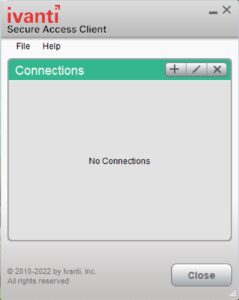
3. Click on the "+" sign to add a connection.
4. In the Name field enter a description name for your SSLVPN profile.
In the Server URL field put in the server name for your SSLVPN Profile:
- (example: https://vpngateway.yorku.ca/vpnyork for regular VPN) in the Server URL field and click ADD.
Steps to Download Ivanti Secure and Pulse Secure
1.
- Pulse Secure version 9.1r15.4-b17585*
- Pulse Secure version 9.1r15.2-b17113
- Ivanti Secure Version 22.6r1.2-b27593*
- Ivanti Secure Version 22.3r2.0-b19787
* Latest Version
2. If you are using Mozilla Firefox then click on the installer and login to Passport York when prompted.
3. Then click on the installer again while pressing the “Control” button on your keyboard, click on "Save link as" to download Pulse Secure to a location of your choice.
4. Open the Package > click Continue, click Install> Click Close to complete the installation.
**Please note if you see a pop-up error message that states "PulseSecure.dmg can't be opened because it is from an unidentified developer", then click ok. Click on System Preferences > Security and Privacy. Click on the lock to make changes if necessary. Make sure that under Allow apps downloaded from, Anywhere is selected. Repeat Step 2 and complete the installation.
Steps to Configure Pulse Secure on MacOS
1. To start Pulse Secure select the Pulse Secure icon from the Applications folder.

2. To create a new connection:
3. Click the plus sign "+"
4. Enter a name for the connection for e.g. My VPNYork.
5. Enter the URL for your SSLVPN (e.g. https://vpngateway.yorku.ca/vpnyork) and enter it in the Server URL field and click ADD.
6. Click Add.

7. Click Connect to start your SSLVPN session
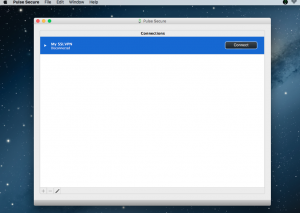
8. Enter your PPY username and password.
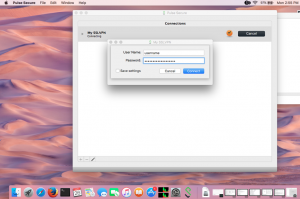
9. The Pulse Secure icon in the status bar indicates an active SSLVPN session.
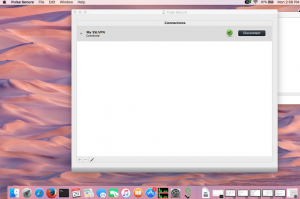
Download the appropriate client:
- CentOS/RHEL Version 9.1r15.4-b17585 * (64-bit)
- CentOS/RHEL Version 22.6r1.2-b27593 * (64-bit)
- Linux RPM Version 9.1r15.4-b17585* (64-bit)
- Linux RPM Version 22.6r1.2-b27593* (64-bit)
- Ubuntu/Debian Version 9.1r15.4-b17585 * (64-bit)
- Ubuntu/Debian Version 22.6r1.2-b27593 * (64-bit)
* Latest Version
Installing VPN Client for Linux
The Pulse Secure client for Linux supports CLI-based installation.
The nss3-tools and net-tools are dependency packages required to successfully install the Pulse Client. Use the following commands to install these dependency tools manually.
Fedora: yum install
Ubuntu and Debian: apt-get install < dependency tool name >
The Installation Command:
Debian – based installation
dpkg -i
RPM – based installation
rpm -ivh
The Uninstallation Command:
Debian – based installation
dpkg -r
RPM – based installation
rpm -e
The upgrade from old Pulse client to new Pulse client is not supported.
**Please note if you have the old Junos Pulse app installed you must first uninstall this before installing Pulse Secure.
1. On your iOS device, open the App Store and search for Ivanti Secure Access Client
(Alternatively you can go directly to the Ivanti Secure App Store page using Safari)
2. Tap Get beside "Ivanti Secure Access Client" from company "Pulse Secure LLC"
3. Tap Install
4. After installation is complete open the Pulse Secure app
5. The first time you launch the software you must click "Accept" to accept the license agreement.
6. Tap Enable Ivanti Secure Access Client
7. On the VPN tab select Configuration
8. Enter the following information:
Name: This field can be left blank or you can type whatever you wish e.g. York VPN
URL: Enter the VPN Link that you wish to connect to. For most people this will be: https://vpngateway.yorku.ca/vpnyork
Username: Enter your Passport York username
Authentication: Leave this as Password
Realm: Leave this field blank
Role: Leave this field blank
9. Tap Save
10. At the main Pulse screen tap Connect
11. Type in your Passport York password at the following screen.
12. Tap Sign In
13. You should be taken back to the main Pulse Secure screen and see: Status Connected. You should also see the "VPN" box in the iOS status bar.
**Please note if you have the old Junos Pulse app installed you must first uninstall this before installing Ivanti Secure.
Steps to Download Ivanti Secure
1. On your Android Device, open Google Playstore and search for Ivanti Secure. (Alternatively you can go directly to the Ivanti Secure Google Playstore page using Chrome)
2. Tap Ivanti Secure
3. Tap Install and then Accept
Steps to Configure Ivanti Secure
1. Tap Open to launch Ivanti Secure
2. Tap Accept to accept the End User License Agreement (You only have to do this once)
3. Tap on Add Connection
4. Enter the following information:
Name: Type the name for your VPN connection. For example My VPNYork
URL: Enter the VPN Link that you wish to connect to. For most people this will be: https://vpngateway.yorku.ca/vpnyork
Username: Enter your Passport York username
Authentication Type: Ensure Password is selected
Realm: Leave this field blank
Role: Leave this field blank
5. Tap on Create Connection
6. The newly created connection is now listed on the Connections listing.
7. To open a VPN connection tap Connect on the main Ivanti screen
8. The Secure Remote Access login page is presented. Enter your PPY username and password and tap Sign In
9. In the Connection request screen tap Ok (You only have to do this once)
10. To see the VPN Status details select Status. This entry lists your assigned SSLVPN YorkU IP and other connection details.
11. You should be taken back to the main Ivanti Secure screen and see: Status Connected. If not, then you can press the back button. You should also see a key icon in the Android status bar.
12. To end your VPN session Tap Signout
Connect to VPN:
If you already have Ivanti Secure Access installed and setup for you by your Faculty IT support team read the instructions below for how to connect to York's VPN.
1. On your system tray, in the bottom-right of your screen, click the up arrow and locate the Pulse Secure icon.
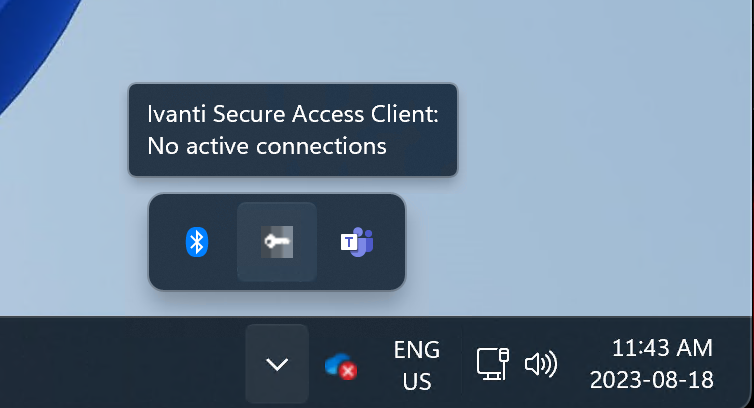
2. Right-click on the Pulse Secure Icon and choose “Open Pulse Secure”.
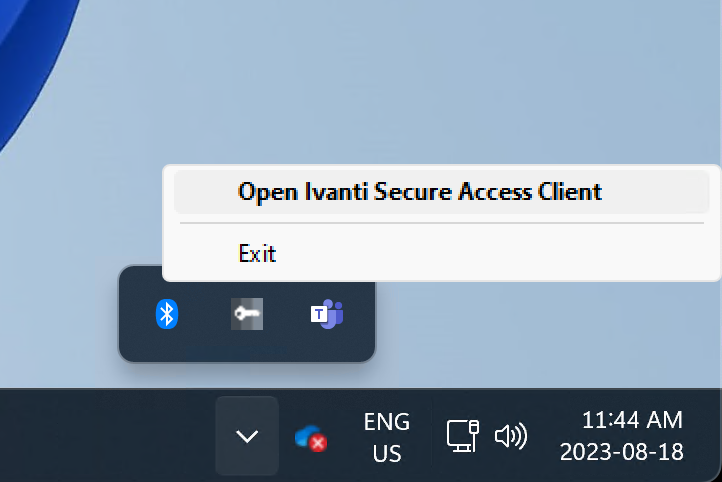
3. In the Pulse Secure window, choose "Connect" on the VPN Profile that you normally connect to.
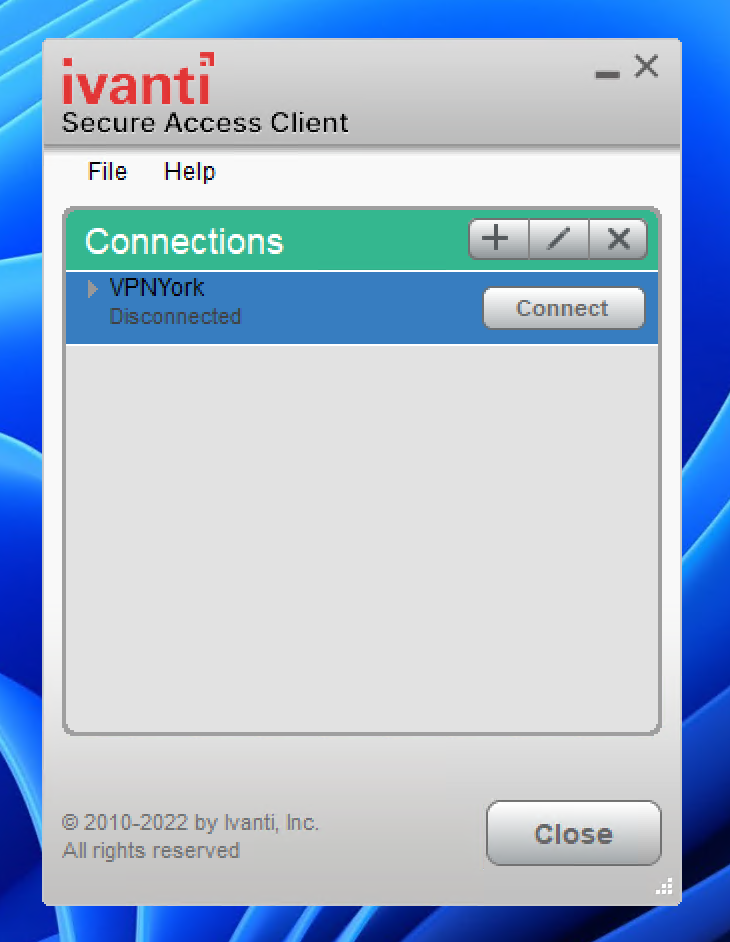
- In the case that you do not see any VPN profiles listed, click the “+” icon.
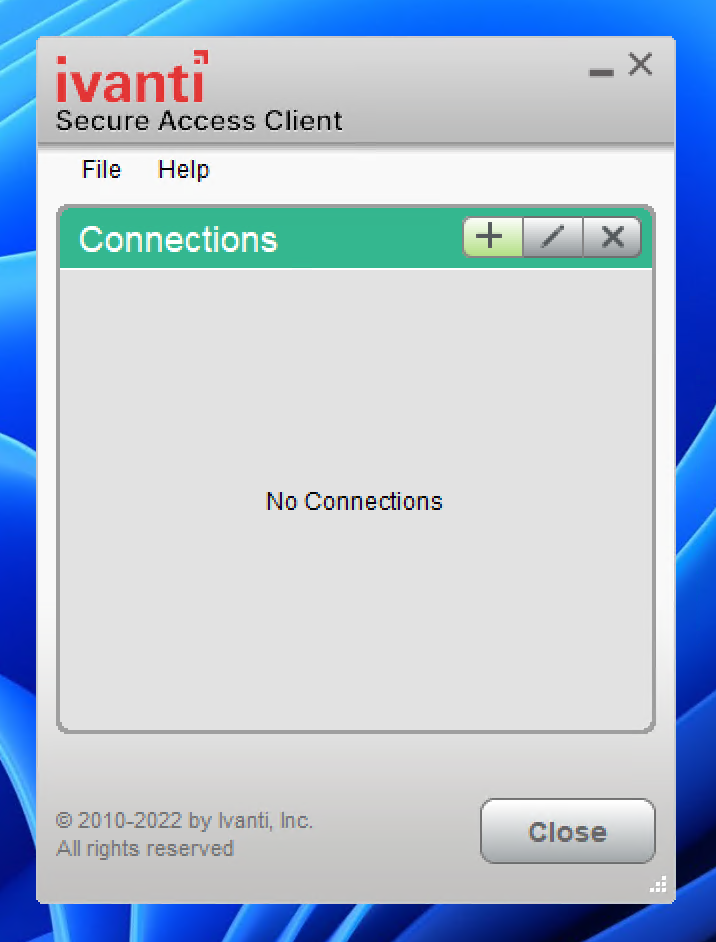
- In the box that appears, enter the details as shown in the image below, then click “Connect”.
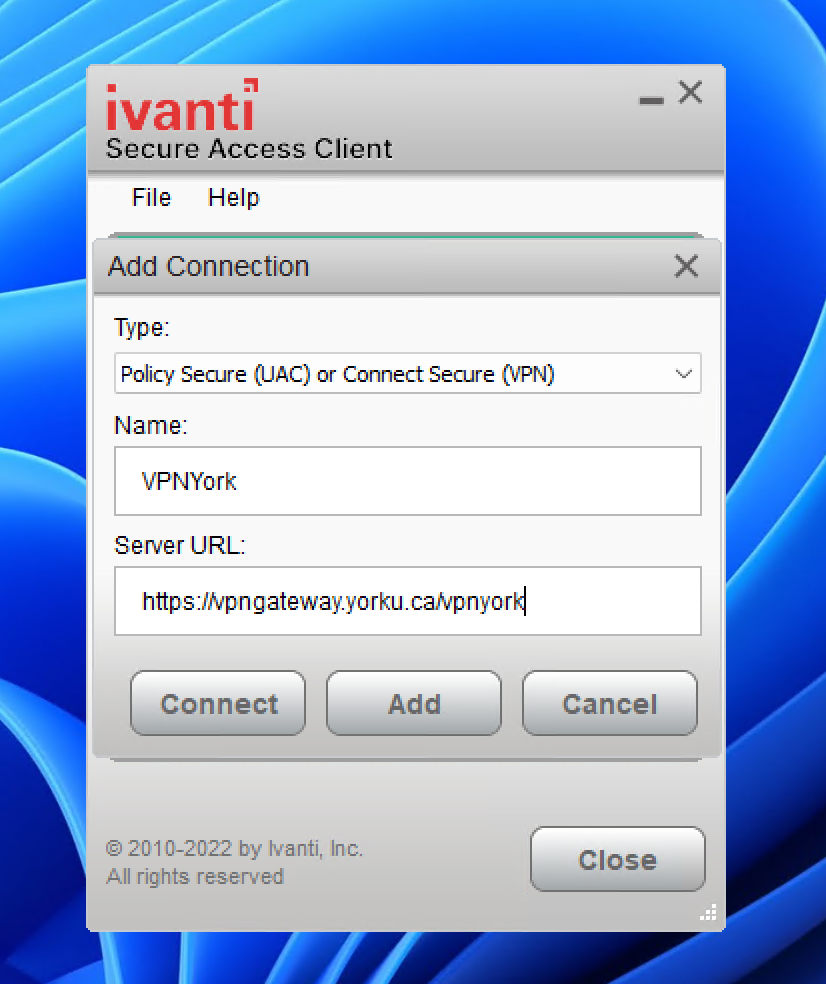
4. In the box that pops-up as shown below, enter your Passport York username and password, then click “Connect” (You can choose whether or not to check the box to save your credentials).
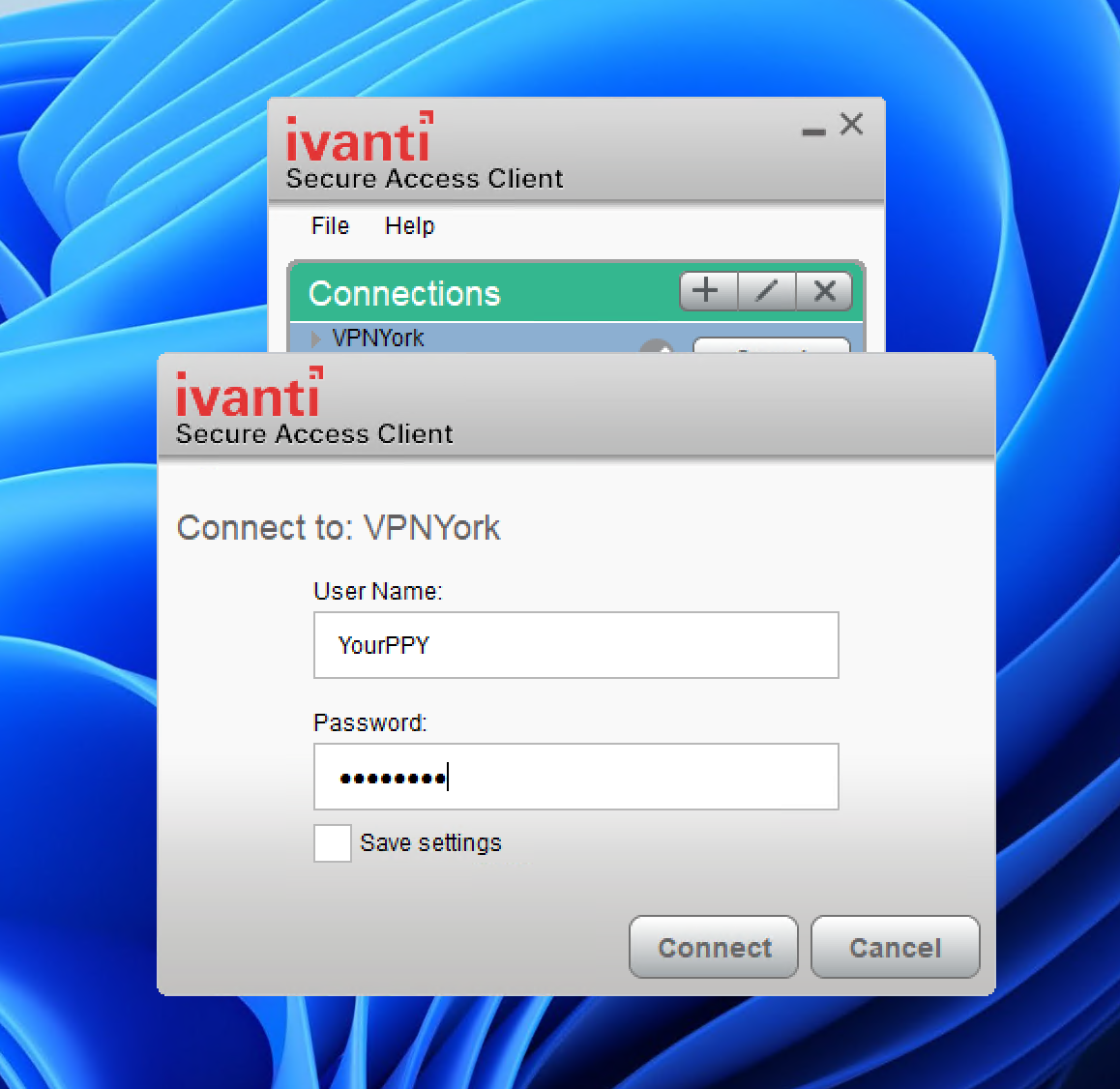
5. After clicking connect, you will need to open the Duo app on your phone and approve the Duo Push to connect to VPN. If you are using an alternative method of authentication (e.g. you are using a Duo Token or are enrolled in 2FA/Duo via SMS/Text Messaging), or have more than one device registered on your Duo profile, please follow the instructions on this page to authenticate your login attempt.
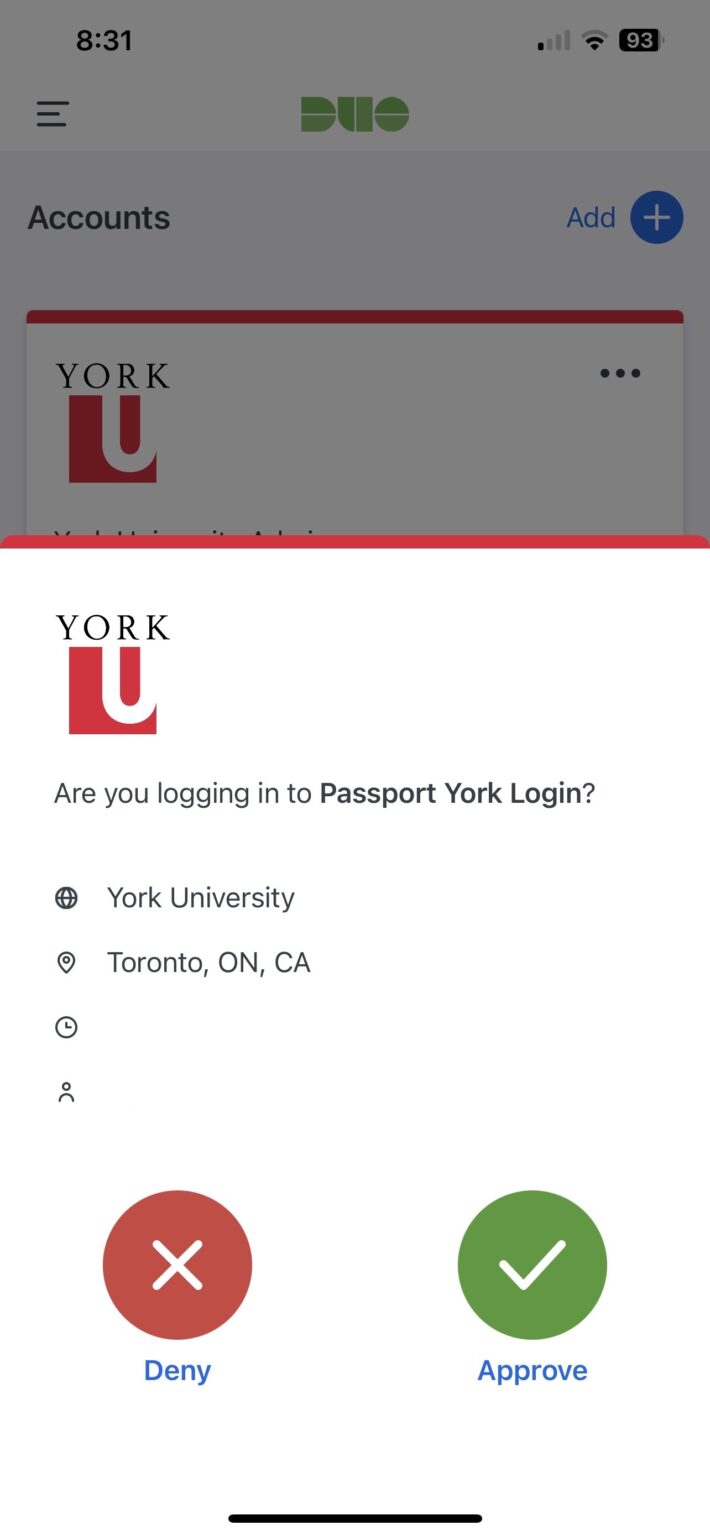
6. The VPN is successfully connected when you see the screen as below.
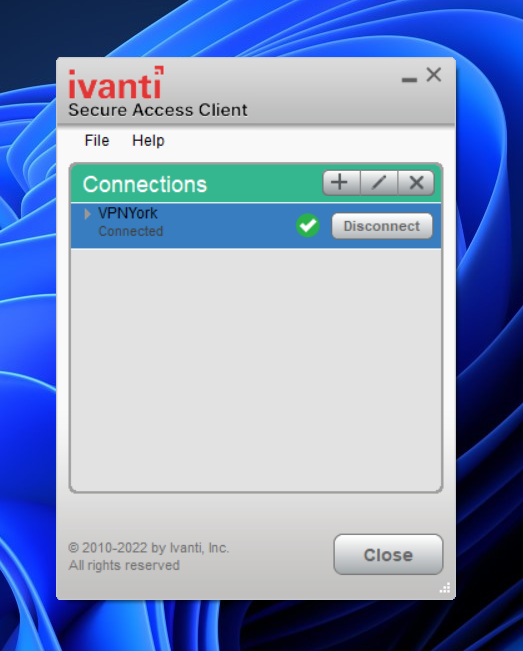
If you receive an "Invalid Credentials" error, please try Forgetting your Saved Settings and try steps 4-6 again.
Frequently Asked Questions
Wi-Fi Client Device Recommendations:
For optimal Wi-Fi performance at York University, it is required that a Wi-Fi client (laptop, tablet, smartphone, etc) be:
- Wi-Fi Certified
- This ensures client devices are tested against Wi-Fi industry standards for interoperability, security, easy installation, and reliability and are compatible with the infrastructure supporting the Wi-Fi access services offered at York University.
- Supports Wi-Fi 6 or Wi-Fi 5
- The ability to support the latest Wi-Fi standards ensures optimal Wi-Fi speeds are attainable and can be achieved in high-density settings such as lecture halls and libraries.
Health Canada has determined that there is no scientific reason to consider Wi-Fi equipment dangerous to the public. No precautionary measures are needed since radio frequency energy exposure levels from wi-fi are typically well below Canadian and international safety limits.
AirYorkPLUS FAQs
If you have not changed your password in over a year you may need to change it now. Follow the instructions below to change your password:
- Close all open browser windows.
- Start up web browser and go to mms.yorku.ca
- Click on the check box beside "Click this box before logging into to change your Passport York password". Log in using your current Passport York username and password. Follow the prompts to change password. Note: Password can only be 7 or 8 characters long and may not contain a semi-colon (;) or double quotes (").
- Wait around 10 minutes before connecting to AirYorkPLUS.
**Please note if you have forgotten your username or password then follow the instructions for resetting Passport York .
This is due to a mis-configured Wi-Fi client profile. Delete the Wi-Fi profile for AirYorkPLUS from your device and then recreate it. Use the the AirYorkPLUS Setup Application tool if your computer is MS-Windows.
If you see the following message, it means you have not followed the AirYorkPLUS configuration instructions fully. However, you can still connect to AirYorkPLUS and not see this message again by clicking on the Details arrow and verifying the following:
- Radius Server: authenticate.yorku.ca
- Root CA: GlobalSign Root CA
- Once verified, click Connect.
For best performance, particularly In high-density settings such as lecture halls and libraries, you need to ensure that the Wi-Fi radio in your client device is capable of supporting the performance features of AirYorkPLUS. Your experience of Wi-Fi performance on-campus may suffer if your wireless client device cannot operate in the 5 GHz radio band, and if it does not support the Wi-Fi 5 protocol or later. For more information on how to achieve optimal Wi-Fi speeds at York, please consult UIT's recommendations on selecting / purchasing a Wi-Fi client device.
For Windows 10 / 11 users there are a few network adapter settings available that can help ensure optimal performance.
1. Click the Windows icon on your keyboard or bottom left of your screen and search for “Command Prompt” as an administrator (by searching for it in the same way but right clicking on it and selecting “Run as administrator”) and run the command by copying and pasting this and pressing enter:
control.exe /name Microsoft.NetworkAndSharingCenter.
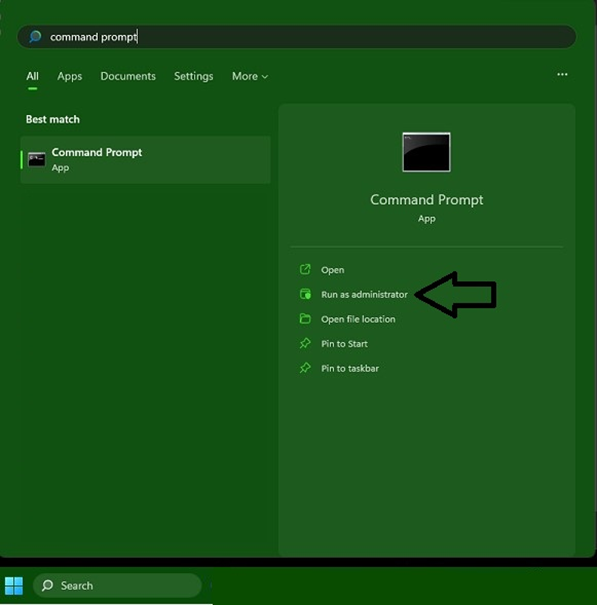
2. Click on “Connections: Wi-Fi (AirYorkPlus)” and a new window should pop up.
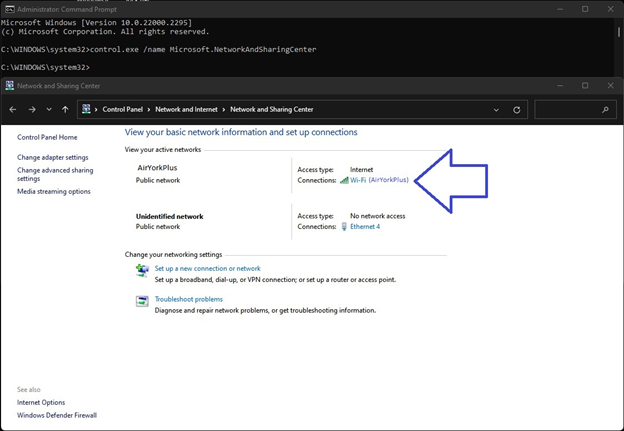
3. Click on “Properties” and a new window should pop up.
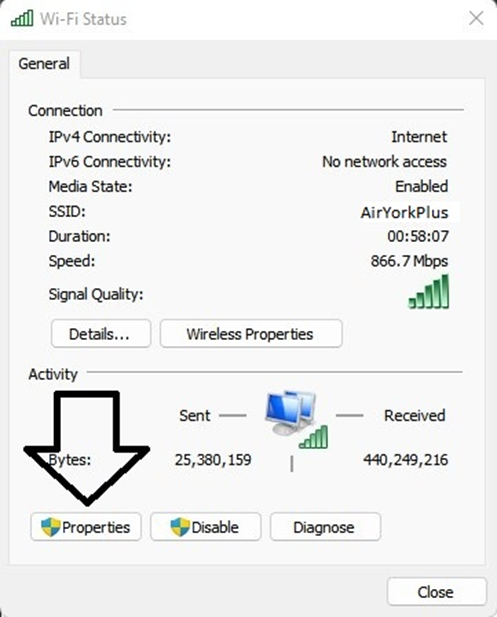
4. Click on “Configure” and a new window should pop up.
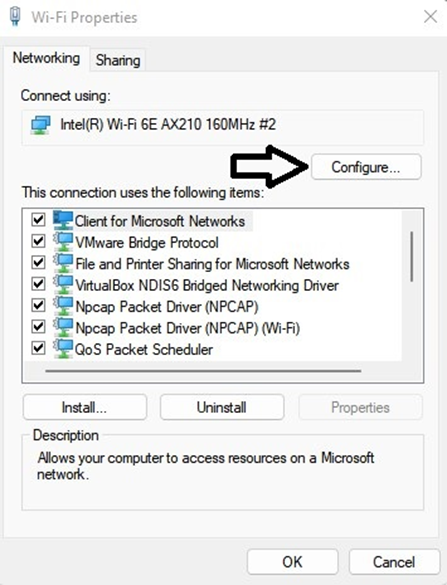
AirYorkGUEST FAQs
To access the AirYorkGUEST network, you must have a Wi-Fi client which is capable of connection to 802.11 a/g/n/ac and which has a web browser which may be used to complete the registration process. You must also have at least one of the following: a working email address, a working cellular phone or tablet which can receive a text message (aka SMS, Short Message Service.)
AirYorkGUEST is intended for convenience use by short-term visitors to York University who do not have a valid eduroam or Passport York account. If you are still experiencing issues, please contact us at https://askus.yorku.ca/portal.
Your AirYorkGUEST session will be automatically terminated after 10 minutes have elapsed. You are free to re-start the registration process at any time after the previous session has been terminated.
Unlike eduroam or AirYorkPLUS, the AirYorkGUEST network does not encrypt network traffic over-the-air. If AirYorkGUEST is to be used to transmit or receive any information which is either confidential or sensitive, it is strongly recommended that the end-user should login to an encrypting VPN service after connecting to AirYorkGUEST and/or to only use applications which themselves encrypt their network traffic.
AirYorkGUEST is available at all York campuses and remote offices where eduroam and AirYorkPLUS are also available.
If there are reports of nuisance registrations, that particular device will be blocked from using the AirYorkGUEST service. To investigate further please contact askit@yorku.ca.
You can only use the activation information once from the device it was requested from.
Charges may apply given your phone plan.
Please contact UIT at askit@yorku.ca. Approval for this would be dealt with on a case by case basis.
Internet in Residence FAQs
Up to 25Mbps for both wireless and wired upload and download speeds.
Personal Wi-fi Routers and access points (any extension of the York network) are NOT permitted. Please see the Residence Internet Subscriber Agreement for more details.
No, you do not need to cancel your York Internet service in your residence. You can just take your personal computer, equipment, and cables with you, but leave anything that is part of the York University infrastructure in place (e.g. if your room has a white wall mounted network access point).
Yes. When you want to terminate the service, please submit a termination request using the Service Request Form. We will contact you to arrange the return of the VoIP phone. Monthly charges will continue to be billed to your account until we receive notice from you to terminate your service and the phone is returned so please remember to cancel your service if you move out.
Please note VoIP phones are property of York University. A charge of $100.00 will be applied to your Student Account for a missing or damaged phone.
A wired network connection is recommended and is the easiest way to get a smart TV working - simply plug your smart TV into the data port marked either LAN 2 or LAN 3 on the CISCO white coloured wall mount Access Point with a network cable (if you don't have this e.g. in Calumet or Pond residences, then connect to the single blue network jack you have). If you want to get a smart TV working wirelessly, please click here>>
No, York University does not provide network cables. You will have to provide your own network cable. Please note that a CAT5 or higher network cable is recommended.
Each residence suite is equipped with an access point to provide wireless service as well as wired service regardless of any current external service arrangements with an external provider (Rogers, Bell, etc.). Please note that it is the resident's responsibility to arrange for the termination of any service (Rogers, Bell, etc.) if the service is no longer in use to avoid further unwanted charges, etc.
Cable TV service is provided directly by Rogers Communications to Assiniboine and Passy Crescent suites. Please call 1-800-784-6678 or email Rogers at gta.directsales@rci.rogers.com to order the service. You must reach out to them first, and Rogers Communications should have an internal process to contact UIT at York University so that their technicians can schedule and make a site visit to arrange for access to the necessary network conduits and establish their service connections.
If you reside in York Apartments such as Assiniboine and Passy Crescent, you have the option to obtain the services of an external service provider such as Rogers or Bell. To begin the process, you need to initiate a conversation with the chosen service provider to determine if they offer services to your location. Once confirmed, the service provider will contact askIT@yorku.ca to arrange for their technicians to schedule a site visit. During the visit, the technicians will access the necessary network conduits and establish the required service connections.
VPN FAQs
All users have access to the VPNYork Profile. Access to any other specific VPN group requires further coordination with a York University profile owner (designate).
- York University profile owner (designate) must be involved in this request process.
- York University profile owner (designate) must put in service request on behalf of the client.
- If this person is outside of York then a Guest Account must be requested first via Halo and then following the creation of the Guest Account a separate VPN Profile request must be submitted on behalf of the guest.
- If the person is a York University Community member then the VPN Profile request form must be completed. Please fill out the "SSLVPN Request" form under the "IT Forms" section on Halo.
- Use VPN service profile as per instructions from the York University profile owner (designate).
- Due to the VPNFW1 access control policies users of the vpnfw1 profile will not be able to access yu link without logging off from Ivanti Secure Access.
See the list of Supported Browsers
Disable the Mac feature "Back to my Mac". This feature causes conflicts with the Pulse Secure's operating port. After disabling "Back to my Mac" restart the client.
VPN sessions end when the session clock runs out. Below are the timeouts for the various VPN profiles.
Idle time i.e. Maximum time that the VPN session may be idle (no traffic): 10-30 minutes (Varies by VPN profile)
Session time i.e. Maximum duration of the session: 480- 600 minutes (8-10 hours)
Reminder time i.e. Warning issued x minutes before the session is closed: 5-10 minutes
- Detailed problem description
- Date/time of problem or event
- VPN Profile name (For example: vpnyork or vpnfw1, etc.)
- Full URL exactly as configured in your Pulse Secure client.
While you can skip the message and continue on to connecting with VPN, we recommend that you download the latest version of Anti Virus and run a system scan before continuing to connect with VPN.
eduroam FAQs
If you are visiting York University from another institution, please contact your home institution for instructions on connecting to eduroam at York.
If you are a York University Community member, please contact USC Client Services at askit@yorku.ca or 416-736-5800.
Reset your Passport York password>>.
If you have not changed your password in over a year you may need to change it now.
This is due to a mis-configured Wi-Fi client profile. Delete the Wi-Fi profile for eduroam from your device and then recreate it.
If you see this message, it means you have not followed the eduroam configuration instructions fully. However, you can still connect to eduroam and not see this message again by clicking on the details arrow and verifying the following:
- Radius Server: authenticate.yorku.ca
- Root CA: GlobalSign Root CA
- Once verified, click Connect.
For best performance, particularly In high-density settings such as lecture halls and libraries, you need to ensure that the Wi-Fi radio in your client device is capable of supporting the performance features of AirYorkPLUS. Your experience of Wi-Fi performance on-campus may suffer if your wireless client device cannot operate in the 5 GHz radio band, and if it does not support the Wi-Fi 5 protocol or later. For more information on how to achieve optimal Wi-Fi speeds at York, please consult UIT's recommendations on selecting / purchasing a Wi-Fi client device.
For Windows 10 / 11 users there are a few network adapter settings available that can help ensure optimal performance.
1. Click the Windows icon on your keyboard or bottom left of your screen and search for “Command Prompt” as an administrator (by searching for it in the same way but right clicking on it and selecting “Run as administrator”) and run the command by copying and pasting this and pressing enter:
control.exe /name Microsoft.NetworkAndSharingCenter.

2. Click on “Connections: Wi-Fi (AirYorkPlus)” and a new window should pop up.

3. Click on “Properties” and a new window should pop up.

4. Click on “Configure” and a new window should pop up.


Learn More
Not finding what you are looking for or need technical assistance? We are here to support you!
